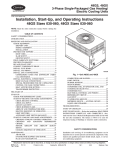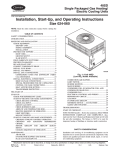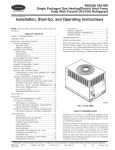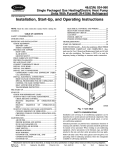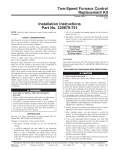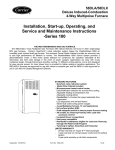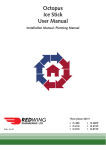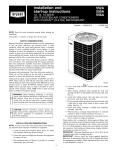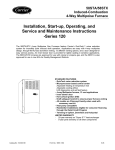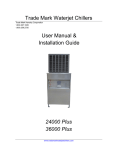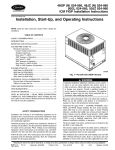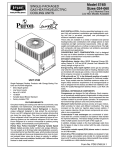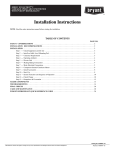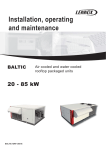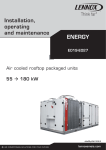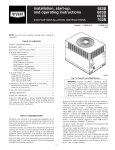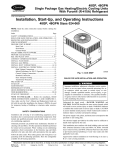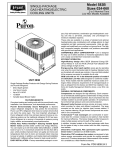Download Installation, Start-Up, and Operating Instructions
Transcript
48XP(N) 024-060 Single Packaged Gas Heating/Electric Cooling Units With Puron® (R-410A) Refrigerant Visit www.carrier.com Installation, Start-Up, and Operating Instructions NOTE: Read the entire instruction manual before starting the installation. TABLE OF CONTENTS EVAPORATOR AIRFLOW .............................................25 PURON® ITEMS..............................................................25 TROUBLESHOOTING ...............................................................27 START-UP CHECKLIST............................................................27 SAFETY CONSIDERATIONS .....................................................1 INTRODUCTION ..........................................................................2 RECEIVING AND INSTALLATION ..........................................2 CHECK EQUIPMENT.............................................................2 IDENTIFY UNIT ................................................................2 INSPECT SHIPMENT ........................................................2 PROVIDE UNIT SUPPORT....................................................2 ROOF CURB.......................................................................2 SLAB MOUNT ...................................................................2 GROUND MOUNT ............................................................2 FIELD FABRICATE DUCTWORK........................................2 PROVIDE CLEARANCES ......................................................2 RIG AND PLACE UNIT .........................................................6 CONNECT CONDENSATE DRAIN ......................................7 INSTALL FLUE HOOD ..........................................................7 INSTALL GAS PIPING...........................................................8 INSTALL DUCT CONNECTIONS ........................................9 CONFIGURING UNITS FOR DOWNFLOW (VERTICAL) DISCHARGE ..........................................................10 INSTALL ELECTRICAL CONNECTIONS.........................10 HIGH-VOLTAGE CONNECTIONS................................11 SPECIAL PROCEDURES FOR 208-V OPERATION ...11 CONTROL VOLTAGE CONNECTIONS.......................11 Easy Select™—48XP........................................................11 TRANSFORMER PROTECTION....................................14 NOTE TO INSTALLER — Before the installation, READ THESE INSTRUCTIONS CAREFULLY AND COMPLETELY. Also, make sure the User’s Manual and Replacement Guide are left with the unit after installation. The furnace is NOT to be used for temporary heating of buildings or structures under construction. PRE-START-UP ..........................................................................14 START-UP ...................................................................................15 CHECK FOR REFRIGERANT LEAKS ...............................15 Unit Sequence of Operation ...................................................15 48XP Sequence of Operation............................................15 START-UP HEATING AND MAKE ADJUSTMENTS......18 CHECK HEATING CONTROL.......................................18 START-UP COOLING AND MAKE ADJUSTMENTS......19 CHECKING COOLING CONTROL OPERATION .......19 MAINTENANCE.........................................................................20 AIR FILTER......................................................................23 EVAPORATOR BLOWER AND MOTOR.....................24 FLUE GAS PASSAGEWAYS .........................................24 COMBUSTION-AIR BLOWER.......................................24 LIMIT SWITCH................................................................24 BURNER IGNITION ........................................................24 MAIN BURNERS .............................................................24 CONDENSER COIL, EVAPORATOR COIL, AND CONDENSATE DRAIN PAN..........................................25 CONDENSER FAN ..........................................................25 ELECTRICAL CONTROLS AND WIRING ..................25 REFRIGERANT CIRCUIT...............................................25 GAS INPUT ......................................................................25 C99088 Fig. 1—Unit 48XP SAFETY CONSIDERATIONS Installation and servicing of air-conditioning equipment can be hazardous due to system pressure and electrical components. Only trained and qualified personnel should install, repair, or service air-conditioning equipment. Untrained personnel can perform basic maintenance functions of cleaning coils and filters. All other operations should be performed by trained service personnel. When working on air-conditioning equipment, observe precautions in the literature, tags, and labels attached to the unit, and other safety precautions that may apply. Follow all safety codes. Wear safety glasses and work gloves. Use quenching cloth for unbrazing operations. Have fire extinguisher available for all brazing operations. Manufacturer reserves the right to discontinue, or change at any time, specifications or designs without notice and without incurring obligations. Book 1 4 PC 101 Catalog No. 534–80239 Printed in U.S.A. Form 48XP-3SI Pg 1 5-04 Replaces: 48XP-2SI Tab 1a 6a To prevent loss or damage, leave all parts in original packages until installation. Improper installation, adjustment, alteration, service, maintenance, or use can cause carbon monoxide poisoning, fire, or an explosion which can result in personal injury or unit damage. Consult a qualified installer, service agency, or gas supplier for information or assistance. The qualified installer or agency must use only factory-authorized kits or accessories when modifying this product. Step 2—PROVIDE UNIT SUPPORT ROOF CURB Install accessory roof curb in accordance with instructions shipped with curb (See Fig. 4 for roof curb dimensions). Install insulation, cant strips, roofing, and flashing. Ductwork must be attached to curb. IMPORTANT: The gasketing of the unit to the roof curb is critical for a watertight seal. Install gasketing material supplied with the roof curb. Improperly applied gasketing can also result in air leaks and poor unit performance. Before performing service or maintenance operations on unit, turn off gas supply to unit. Then turn off unit main power switch. Electrical shock or explosion could cause serious injury or death. Curb should be level to within 1/4 in. This is necessary for unit drain to function properly. Refer to accessory roof curb installation instructions for additional information as required. Recognize safety information. This is the safety-alert symbol . When you see this symbol in instructions or manuals, be alert to the potential for personal injury. SLAB MOUNT Place the unit on a solid, level concrete pad that is a minimum of 4 in. thick with 2 in. above grade. The slab should be flush on the compressor end of the unit (to allow condensate drain installation) and should extend 2 in. on the three remaining sides of the unit. Do not secure the unit to the slab except when required by local codes. Understand the signal words DANGER, WARNING, CAUTION, and NOTE. These words are used with the safety-alert symbol. DANGER identifies the most serious hazards which will result in severe personal injury or death. WARNING signifies a hazard which could result in personal injury or death. CAUTION is used to identify unsafe practices which would result in minor personal injury or product and property damage. NOTE is used to highlight suggestions which will result in enhanced installation, reliability, or operation. GROUND MOUNT The unit may be installed either on a slab or placed directly on the ground if local codes permit. Place the unit on level ground prepared with gravel for condensate discharge. Step 3—FIELD FABRICATE DUCTWORK These instructions cover minimum requirements and conform to existing national standards and safety codes. In some instances, these instructions exceed certain local codes and ordinances, especially those that may not have kept up with changing residential construction practices. We require these instructions as a minimum for a safe installation. INTRODUCTION The 48XP unit (See Fig. 1) is a fully self-contained, combination Category I gas heating/electric cooling unit designed for outdoor installation (See Fig. 2 and 3 for unit dimensions). All unit sizes have return and discharge openings for both horizontal and downflow configurations, and are factory shipped with all downflow duct openings covered. Units may be installed either on a rooftop, a cement slab, or directly on the ground if local codes permit (See Fig. 4 for roof curb dimensions). Secure all ducts to roof curb and building structure on vertical discharge units. Do not connect ductwork to unit. For horizontal applications, unit is provided with flanges on the horizontal openings. All ductwork should be secured to the flanges. Insulate and weatherproof all external ductwork, joints, and roof openings with counter flashing and mastic in accordance with applicable codes. Ducts passing through an unconditioned space must be insulated and covered with a vapor barrier. If a plenum return is used on a vertical unit, the return should be ducted through the roof deck to comply with applicable fire codes. A minimum clearance is not required around ductwork. Cabinet return-air static shall not exceed -.25 in. wg. Step 4—PROVIDE CLEARANCES Models with an N in the thirteenth position of the model number are dedicated Low NOx units designed for California installations. The required minimum operating and service clearances are shown in Fig. 2 and 3. Adequate combustion, ventilation and condenser air must be provided in accordance with section 5.3, Air for Combustion and Ventilation, of the National Fuel Gas Code ANSI (American National Standards Institute) Z223.1 or applicable provisions of local building code. In Canada, follow sections 7.2, 7.3, or 7.4 or Can/CGA. (Canadian Gas Association) B149 Installation Codes or applicable provisions of local building code. These models meet the California maximum oxides of nitrogen (NOx) emissions requirements of 40 nanograms/joule or less as shipped from the factory and must be installed in California Air Quality Management Districts where a Low NOx rule exists. RECEIVING AND INSTALLATION Step 1—CHECK EQUIPMENT IDENTIFY UNIT The unit model number and serial number are stamped on unit identification / rating plate. Check this information against shipping papers and job data. Do not restrict condenser airflow. An air restriction at either the outdoor-air inlet or the fan discharge can be detrimental to compressor life. INSPECT SHIPMENT Inspect for shipping damage while unit is still on shipping pallet. If unit appears to be damaged or is torn loose from its anchorage, have it examined by transportation inspectors before removal. Forward claim papers directly to transportation company. Manufacturer is not responsible for any damage incurred in transit. The condenser fan pulls air through the condenser coil and discharges it through the top cover. Be sure that the fan discharge does not recirculate to the condenser coil. Do not locate the unit in either a corner or under an overhead obstruction. The minimum clearance under a partial overhang (such as a normal house overhang) is 48-in. above the unit top. The maximum horizontal extension of a partial overhang must not exceed 48-in.. Check all items against shipping list. Immediately notify the nearest distributor if any item is missing. 2 REQ’D CLEARANCES FOR OPERATION AND SERVICING. in. (mm) REQ’D CLEARANCES TO COMBUSTIBLE MAT’L. in. (mm) Evaporator coil access side . . . . . . . . . . . . . . . . . . 36 (914) Power entry side (except for NEC requirements) . . . . . . . . . 36 (914) Unit top . . . . . . . . . . . . . . . . . . . . . . . . . . 48 (1219) Side opposite ducts . . . . . . . . . . . . . . . . . . . . . 36 (914) Duct panel . . . . . . . . . . . . . . . . . . . . . . . . 12 (304.8)* Flue Panel . . . . . . . . . . . . . . . . . . . . . . . . . . . . . .36 (914.4) *Minimum distances: If unit is placed less than 12 in. (304.8 mm) from wall system, then the system performance may be compromised. LEGEND CG - Center of Gravity COND - Condenser EVAP - Evaporator NEC - National Electrical Code REQ'D - Required Note: Dimensions are in in. (mm) Top of unit . . . . . Duct side of unit . . Side opposite ducts . Bottom of unit . . . . . . . . . . . . . . . . . . . . . . . . . . . . . . . . . . . . . . . . . . . . . . . . . . . . . . . . . . . . . . . . . . . . . . . . . . . . . . . . 14 (355.6) . . 2 (50.8) . 14 (355.6) . 0.50 (12.7) NEC REQ’D CLEARANCES. in. (mm) Between units, power entry side . . . . . . . . . . . . . . 42 (1066.8) Unit and ungrounded surfaces, power entry side . . . . . . . . . 36 (914) Unit and block or concrete walls and other grounded surfaces, control box side . . . . . . . . . . . . . . . . . 42 (1066.8) C99017 CENTER OF GRAVITY IN. (MM) kg UNIT HEIGHT IN. (MM) ″A″ X Y Z 159 39.02 (991.1) 20 (508) 19.3 (489) 17.6 (447) UNIT WEIGHT UNIT ELECTRICAL CHARACTERISTICS lb 48XP024-040/060 208/230-1-60 350 48XP030-040/060 208/230-1-60 350 159 39.02 (991.1) 20 (508) 19.3 (489) 17.6 (447) 48XP036-060/090 208/230-1-60, 208/230-3-60 388 176 41.02 (1041.9) 20.0 (508) 14.0 (355.6) 13.0 (330.2) Fig. 2—48XP024-036 Unit Dimensions Do not place the unit where water, ice, or snow from an overhang or roof will damage or flood the unit. Do not install the unit on carpeting, tile, or other combustible materials. The unit may be installed on wood flooring or on Class A, B, or C roof covering materials. 3 REQUIRED CLEARANCE FOR OPERATION AND SERVICING REQUIRED CLEARANCE TO COMBUSTIBLE MATL. in. [mm] EVAP. COIL ACCESS SIDE..............................................................36.00 [914.0] POWER ENTRY SIDE......................................................................36.00 [914.0] (EXCEPT FOR NEC REQUIREMENTS) UNIT TOP .........................................................................................36.00 [914.0] SIDE OPPOSITE DUCTS ................................................................36.00 [914.0] DUCT PANEL ...................................................................................12.00 [304.8] * FLUE HEAT PANEL .................................................................36.00 [914.4] *MINIMUM DISTANCES: IF UNIT IS PLACED LESS THAN 12.00 [304.8] FROM WALL SYSTEM, THEN SYSTEM PERFORMANCE MAYBE COMPROMISE. in. [mm] TOP OF UNIT...................................................................................14.00 [355.6] DUCT SIDE OF UNIT.........................................................................2.00 [50.8] SIDE OPPOSITE DUCTS ................................................................14.00 [355.6] BOTTOM OF UNIT .............................................................................0.50 [12.7] NEC. REQUIRED CLEARANCES. in. [mm.] BETWEEN UNITS, POWER ENTRY SIDE ....................................42.00 [1066.8] UNIT AND UNGROUNDED SURFACES, POWER ENTRY SIDE ...36.00 [914.0] UNIT AND BLOCK OR CONCRETE WALLS AND OTHER GROUNDED SURFACES, POWER ENTRY SIDE.........................42.00 [1066.8] FLUE HOOD C99074 ELECTRICAL CHARACTERISTICS lb 48XP042-060/090 208/230-1-60, 208/230-3-60 440 48XP048-090/115/130 208/230-1-60, 208/230-3-60 463 48XP060-090/115/130 208/230-1-60, 208/230-3-60 499 kg X Y Z 200 42.98 (1091.7) 21 (533.4) 20.5 (520.7) 16.6 (421.6) 210.0 44.98 (1142.5) 19.5 (495.3) 21.3 (539.8) 18.0 (457.2) 226 46.98 (1193.3) 21 (533.4) 20 (508) 17.6 (447.0) Fig. 3—48XP042-060 Unit Dimensions 4 CENTER OF GRAVITY IN. (MM) UNIT HEIGHT IN. (MM) ″A″ UNIT WEIGHT UNIT HVAC unit base HVAC unit base Screw (NO TE A) Gask eting inner flange* Screw (NOTE A) Gasketing inner flange* *Gasketing outer flange *Gasketing outer flange Wood nailer* Flashing field supplied Wood nailer* Flashing field supplied Roofcurb* Insulation (field supplied) Roofing material field supplied Insulation (field supplied) Roofing material field supplied Duct wo rk field supplied Cant strip field supplied Roofcurb* Duct wo rk field supplied Cant strip field supplied Roof Roof *Provided with roofcurb *Provided with roofcurb Roof Curb for Small Cabinet Roof Curb for Note A: When unit mounting scre w is used , retainer bracke t must also be used. Large Cabinet Note A: When unit mounting scre w is used , retainer bracket must also be used. Supply opening (B x C) B Typ. 44 5/ 16" D CTyp. R/A S/A A Gasket around duct Insulated deck pan Short Support Insulated deck pan Gasket around outer edge Long Support Return opening (B X C) C00076 UNIT SIZE 48XP024-036 48XP042-060 ODS CATALOG NUMBER CPRFCURB006A00 CPRFCURB007A00 CPRFCURB008A00 CPRFCURB009A00 A IN. (MM) 8 (203) 14 (356) 8 (203) 14 (356) B IN. (MM) 11(279) 11(279) 16 3/16 (411) 16 3/16 (411) C IN. (MM) 161/2 (419) 161/2 (419) 17 3/8 (441) 17 3/8 (441) D IN. (MM) 28-3/4 (730) 28-3/4 (730) 40-1/4 (1022) 40-1/4 (1022) NOTES: 1. Roof curb must be set up for unit being installed. 2. Seal strip must be applied, as required, to unit being installed. 3. Dimensions in ( ) are in millimeters. 4. Roof curb is made of 16-gage steel. 5. Table lists only the dimensions, per part number, that have changed. 6. Attach ductwork to curb (flanges of duct rest on curb). 7. Insulated panels: 1-in. thick fiberglass 1 lb density. 8. Dimensions are in inches. 9. When unit mounting screw is used (see Note A), a retainer bracket must be used as well. This bracket must also be used when required by code for hurricane or seismic conditions. This bracket is available through Micrometl. Fig. 4—Roof Curb Dimensions 5 1 2 y 4 3 x C00070 Corner Corner Corner Corner Weight Weight Weight Weight 1 2 3 4 70 54 84 141 70 54 84 141 → 36 388 CORNER WEIGHTS (LARGE CABINET) Unit 42 48 Total Weight 440 463 Model 48XP Model 48XP CORNER WEIGHTS (SMALL CABINET) Unit 24 30 Total Weight 350 350 78 60 94 156 Corner Corner Corner Corner Weight Weight Weight Weight 1 2 3 4 88 68 106 177 92 72 111 188 60 499 100 78 120 201 Fig. 5—48XP Corner Weights A 914-1371 (36”-54”) DUCTS 927.57 (36”-52”) B SEAL STRIP MUST BE IN PLACE BEFORE PLACING UNIT ON ROOF CURB 1226.3 (48.28”) PLACE RIGGING STRAPS IN BASEPAN SLOT (BELOW RIGGING HOLDS) BEFORE RIGGING C99015 UNIT 48XP 024 030 036 042 048 060 MAXIMUM SHIPPING WEIGHT lb kg 372 372 410 462 485 521 169 169 186 210 220 236 A in. UNIT 48XP 22.0 22.0 22.0 20.0 21.5 23.5 B mm in. mm 558.5 558.5 558.5 508.0 546.1 596.9 14.50 14.50 15.30 21.25 16.3 16.3 368.3 368.3 388.6 539.8 414.0 414.3 Fig. 6—Suggested Rigging Step 5—RIG AND PLACE UNIT Only trained, qualified crane operators and ground support staff should handle and install this equipment. When working with this equipment, observe precautions in the literature, on tags, stickers, and labels attached to the equipment, and any other safety precautions that might apply. When installing the unit on a rooftop, be sure the roof will support the additional weight. Failure to follow this warning may cause personal injury or death. Use spreader bars or crate top when rigging the unit. The units must be rigged for lifting (See Fig. 6). Refer to Table 1 for operating weight. Use extreme caution to prevent damage when moving the unit. Unit must remain in an upright position during all rigging and moving operations.The unit must be level for proper Rigging and handling of this equipment can be hazardous for many reasons due to the installation location (roofs, elevated structures, etc.) 6 Table 1—Physical Data—Unit 48XP UNIT SIZE 48XP 024040 024060 030040 030060 036060 036090 042060 042090 NOMINAL CAPACITY (ton) 2 2 2-1/2 2-1/2 3 3 3-1/2 3-1/2 OPERATING WEIGHT (lb.) 350 350 350 350 388 388 440 440 COMPRESSORS Scroll Quantity 1 REFRIGERANT (R-410A) 7.3 7.3 8.0 8.0 9.5 9.5 10.7 10.7 Quantity (lb.) REFRIGERANT METERING DEVICE TXV CONDENSER COIL 2...21 2...21 2...21 2...21 2...21 2...21 2...21 2...21 Rows...Fins/in. 11.95 11.95 11.95 11.95 13.7 13.7 15.4 15.4 Face Area (sq ft) CONDENSER FAN 2350 2350 2350 2350 2800 2800 2800 2800 Nominal Cfm 22 22 22 22 22 22 22 22 Diameter (in.) 1/8 (825) 1/8 (825) 1/8 (825) 1/8 (825) 1/8 (825) 1/8 (825) 1/8 (825) 1/8 (825) Motor Hp (Rpm) EVAPORATOR COIL 3...15 3...15 3...15 3...15 4...15 4...15 3...15 3...15 Rows...Fins/in. 3.7 3.7 3.7 3.7 3.7 3.7 3.7 3.7 Face Area (sq ft) EVAPORATOR BLOWER 1400 1400 770 770 960 960 1150 1150 Nominal Airflow (Cfm) 11x10 11x10 10x10 10x10 10x10 10x10 11x10 11x10 Size (in.) 3/4 3/4 3/4 1/2 1/2 1/2 1/2 3/4 Motor (hp) FURNACE SECTION* Burner Orifice No. (Qty...Drill Size) 2...44 2...44 2...44 2...44 2...38 3...38 2...38 2...38 Natural Gas 2...50 2...50 2...50 2...50 2...46 3...46 2...46 2...46 Burner Orifice No. (Qty...Drill Size) Propane Gas HIGH-PRESSURE SWITCH (psig) 610 +/- 15 Cut-out 420 +/- 25 Reset (Auto) LOSS-OF-CHARGE / LOW-PRESSURE SWITCH 20 +/- 5 (Liquid Line) (psig) 45 +/- 10 Cut-out Reset (auto) RETURN-AIR FILTERS (in.)† 20 x 24 x 1 20 x 24 x 1 20 x 24 x 1 20 x 24 x 1 20 x 24 x 1 20 x 24 x 1 24 x 30 x 1 24 x 30 x 1 Throwaway * Based on altitude of 0 to 2000 ft. † Required filter sizes shown are based on the larger of the ARI (Air Conditioning and Refrigeration Institute) rated cooling airflow or the heating airflow velocity of 300 ft/minute for high-capacity type. Air filter pressure drop for non-standard filters must not exceed 0.08 in. wg. Model 48XP disposes of condensate water through a 3/4 in. NPT fitting which exits through the compressor access panel (See Fig. 2 and 3 for location). condensate drainage; therefore, the ground-level pad or accessory roof curb must be level before setting the unit in place. When a field-fabricated support is used, be sure that the support is level and properly supports the unit. Lifting point should be directly over the center of gravity for the unit. Condensate water can be drained directly onto the roof in rooftop installations (where permitted) or onto a gravel apron in groundlevel installations. Install a field-supplied condensate trap at end of condensate connection to ensure proper drainage. Make sure that the outlet of the trap is at least 1 in. lower than the drain-pan condensate connection to prevent the pan from overflowing (See Fig. 7). Prime the trap with water. When using a gravel apron, make sure it slopes away from the unit. Never stand beneath rigged units or lift over people. Failure to follow this warning may cause personal injury or death. If the installation requires draining the condensate water away from the unit, install a 2-in. trap at the condensate connection to ensure proper drainage (See Fig. 7). Make sure that the outlet of the trap is at least 1 in. lower than the drain-pan condensate connection. This prevents the pan from overflowing. Never exceed 200 lbs. per bracket lifting force.Failure to follow this warning may cause personal injury or death. Prime the trap with water. Connect a drain tube – using a minimum of 3/4-in. PVC or 3/4-in. copper pipe (all field-supplied) – at the outlet end of the 2-in. trap. Do not undersize the tube. Pitch the drain tube downward at a slope of at least 1-in. for every 10 ft of horizontal run. Be sure to check the drain tube for leaks. Accessory lifting kit is only to be used with Small Packaged units which have a composite unit base with molded rigging holds. Failure to follow this warning may cause personal injury or death. Step 7—INSTALL FLUE HOOD Step 6—CONNECT CONDENSATE DRAIN The flue hood assembly is shipped in the return section of the indoor blower compartment (See Fig. 9). Remove the return duct cover to locate the assembly. NOTE: When installing condensate drain connection be sure to comply with local codes and restrictions. 7 Table 1—Physical Data—Unit 48XP (Continued) UNIT SIZE 48XP NOMINAL CAPACITY (ton) OPERATING WEIGHT (lb.) COMPRESSORS Quantity REFRIGERANT (R-410A) Quantity (lb.) REFRIGERANT METERING DEVICE CONDENSER COIL Rows...Fins/in. Face Area (sq ft) CONDENSER FAN Nominal Cfm Diameter (in.) Motor Hp (Rpm) EVAPORATOR COIL Rows...Fins/in. Face Area (sq ft) EVAPORATOR BLOWER Nominal Airflow (Cfm) Size (in.) Motor (hp) FURNACE SECTION* Burner Orifice No. (Qty...Drill Size) Natural Gas Burner Orifice No. (Qty...Drill Size) Propane Gas HIGH-PRESSURE SWITCH (psig) Cut-out Reset (Auto) LOSS-OF-CHARGE / LOW-PRESSURE SWITCH (Liquid Line) (psig) Cut-out Reset (auto) RETURN-AIR FILTERS (in.)† Throwaway 048090 4 463 048115 4 463 048130 4 463 060090 5 499 060115 5 499 060130 5 499 13.5 13.5 13.5 Scroll 1 11.25 11.25 11.25 TXV 2...21 17.4 2...21 17.4 2...21 17.4 2...21 19.3 2...21 19.3 2...21 19.3 3300 22 1/4 (1100) 3300 22 1/4 (1100) 3300 22 1/4 (1100) 3300 22 1/4 (1100) 3300 22 1/4 (1100) 3300 22 1/4 (1100) 4...15 4.7 4...15 4.7 4...15 4.7 4...17 5.7 4...17 5.7 4...17 5.7 1400 11x10 3/4 (1075) 1400 11x10 3/4 (1075) 1400 11x10 3/4 (1075) 1710 11x10 1.0 (1040) 1710 11x10 1.0 (1040) 1710 11x10 1.0 (1040) 3...38 3...46 3...33 3...42 3...31 3...41 3...38 3...46 3...33 3...42 3...31 3...41 24 x 30 x 1 24 x 30 x 1 24 x 30 x 1 610 +/- 15 420 +/- 25 20 +/- 5 45 +/- 10 24 x 30 x 1 24 x 30 x 1 24 x 30 x 1 * Based on altitude of 0 to 2000 ft. † Required filter sizes shown are based on the larger of the ARI (Air Conditioning and Refrigeration Institute) rated cooling airflow or the heating airflow velocity of 300 ft/minute for high-capacity type. Air filter pressure drop for non-standard filters must not exceed 0.08 in. wg. 1” (25mm) MIN. TRAP OUTLET 1. This installation must conform with local building codes and with the National Fuel Gas Code (NFGC), ANSI Z223.1 (in Canada, CAN/CGA B149.1, and B149.2) or NFPA (National Fire Protection Association) latest revision. Refer to Provincial and local plumbing or wastewater codes and other 2” (50mm) MIN. applicable local codes. 2. Remove flue hood from shipping location (inside the return section of the blower compartment-See Fig. 9). Place vent cap assembly over flue panel. Orient screw holes in vent cap with holes in the flue panel. C99013 Fig. 7—Condensate Trap Dedicated low NOx models MUST be installed in California Air Quality Management Districts where a Low NOx rule exists. 3. Secure flue hood to flue panel by inserting a single screw on the right side and the left side of the hood. These models meet the California maximum oxides of nitrogen (NOx ) emissions requirements of 40 nanograms/joule or less as shipped from the factory. Step 8—INSTALL GAS PIPING The gas supply pipe enters the unit through the access hole provided. The gas connection to the unit is made to the 1/2-in. FPT gas inlet on the manual shutoff or gas valve. NOTE: Low NOx requirements apply only to natural gas installations. Install a gas supply line that runs to the heating section. Refer to Table 2 and the NFGC for gas pipe sizing. Do not use cast-iron pipe. It is recommended that a black iron pipe is used. Check the local utility for recommendations concerning existing lines. Size gas supply piping for 0.5 in. wg maximum pressure drop. Never use pipe smaller than the 1/2-in. FPT gas inlet on the unit gas valve. The venting system is designed to ensure proper venting. The flue hood assembly must be installed as indicated in this section of the unit installation instructions to prevent personal injury or product damage. For natural gas applications, the gas pressure at unit gas connection must not be less than 4.0 in. wg or greater than 13 in. wg while the Install the flue hood as follows: 8 Table 2—Maximum Gas Flow Capacity* NOMINAL IRON PIPE, SIZE (IN.) 1/2 3/4 1 1 1/4 1 1/2 LENGTH OF PIPE, FT† INTERNAL DIAMETER (IN.) 10 20 30 40 50 60 70 80 90 100 125 150 175 200 .622 .824 1.049 1.380 1.610 175 360 680 1400 2100 120 250 465 950 1460 97 200 375 770 1180 82 170 320 600 990 73 151 285 580 900 66 138 260 530 810 61 125 240 490 750 57 118 220 460 690 53 110 205 430 650 50 103 195 400 620 44 93 175 360 550 40 84 160 325 500 — 77 145 300 460 — 72 135 280 430 * Capacity of pipe in cu ft of gas per hr for gas pressure of 0.5 psig or less. Pressure drop of 0.5-in. wg (based on a 0.60 specific gravity gas). Refer to Table, National Fire Protection Association NFPA 54. † This length includes an ordinary number of fittings. 5. Install an accessible, external, manual main shutoff valve in gas supply pipe within 6 ft of heating section. unit is operating. For propane applications, the gas pressure must not be less than 7.0 in. wg or greater than 13 in. wg at the unit connection. 6. Install ground-joint union close to heating section between unit manual shutoff and external manual main shut-off valve. An 1/8-in. NPT plugged tapping, accessible for test gage connection, must be installed immediately upstream of the gas supply connection to the gas valve. 7. Pressure-test all gas piping in accordance with local and national plumbing and gas codes before connecting piping to unit. When installing the gas supply line, observe local codes pertaining to gas pipe installations. Refer to the NFGC ANSI Z223.1-1988 NFPA latest edition (in Canada, CAN/CGA B149.1, (2)-M86). In the absence of local building codes, adhere to the following pertinent recommendations: NOTE: Pressure test the gas supply system after the gas supply piping is connected to the gas valve. The supply piping must be disconnected from the gas valve during the testing of the piping systems when test pressure is in excess of 0.5 psig. Pressure test the gas supply piping system at pressures equal to or less than 0.5 psig. The unit heating section must be isolated from the gas piping system by closing the external main manual shutoff valve and slightly opening the ground-joint union. 1. Avoid low spots in long runs of pipe. Grade all pipe 1/4 in. in every 15 ft to prevent traps. Grade all horizontal runs downward to risers. Use risers to connect to heating section and to meter. 2. Protect all segments of piping system against physical and thermal damage. Support all piping with appropriate straps, hangers, etc. Use a minimum of one hanger every 6 ft. For pipe sizes larger than 1/2 in., follow recommendations of national codes. Unstable operation may occur when the gas valve and manifold assembly are forced out of position while connecting improperly-routed rigid gas piping to the gas valve. Use a backup wrench when making connection to avoid strain on, or distortion of, the gas control piping. 3. Apply joint compound (pipe dope) sparingly and only to male threads of joint when making pipe connections. Use only pipe dope that is resistant to action of liquefied petroleum gases as specified by local and/or national codes. Never use Teflon tape. 4. Install sediment trap in riser leading to heating section (See Fig. 8). This drip leg functions as a trap for dirt and condensate. Unless a flexible conductor is required or allowed by the authority having jurisdiction, black iron pipe shall be installed at the gas valve and shall extend a minimum of 2 in. outside the unit casing to prevent potential gas leaks and personal injury or property or product damage. IN Never use a match or other open flame when checking for gas leaks. Never purge gas line into combustion chamber. Failure to follow this warning could result in an explosion causing personal injury or death. TEE 8. Check for gas leaks at the field-installed and factory-installed gas lines after all piping connections have been completed. Use soap-and-water solution (or method specified by local codes and/or regulations). OUT NIPPLE 3˝ MIN CAP Step 9—INSTALL DUCT CONNECTIONS The unit has duct flanges on the supply- and return-air openings on the side and bottom of the unit. For downshot applications, the ductwork connects to the roof curb (See Fig. 2 and 3 for connection sizes and locations). C99020 Fig. 8—Sediment Trap 9 CONFIGURING UNITS FOR DOWNFLOW (VERTICAL) DISCHARGE Collect ALL screws that were removed. Do not leave screws on rooftop as permanent damage to the roof may occur. Before performing service or maintenance operations on the system, turn off main power to unit. Electrical shock could cause serious injury or death. 5. It is recommended that the base insulation around the perimeter of the vertical return-air opening be secured to the base with aluminum tape. Applicable local codes may require aluminum tape to prevent exposed fiberglass. 1. Open all electrical disconnects before starting any service work. 6. Cover both horizontal duct openings with the provided duct covers. Ensure opening is air- and watertight. 2. Remove horizontal (metal) duct covers to access vertical (downflow) discharge duct knockouts in unit base. 7. After completing unit conversion, perform all safety checks and power up unit. 3. Use a screwdriver and hammer to remove the panels in the bottom of the unit base (See Fig. 9 & 10). NOTE: The design and installation of the duct system must be in accordance with the standards of the NFPA for installation of nonresidence-type air conditioning and ventilating systems, NFPA 90A or residence-type, NFPA 90B; and/or local codes and ordinances. Adhere to the following criteria when selecting, sizing, and installing the duct system: 1. Units are shipped for horizontal duct installation (by removing duct covers). 2. Select and size ductwork, supply-air registers, and return-air grilles according to American Society of Heating, Refrigeration and Air Conditioning Engineers (ASHRAE) recommendations. 3. Use flexible transition between rigid ductwork and unit to prevent transmission of vibration. The transition may be screwed or bolted to duct flanges. Use suitable gaskets to ensure weather tight and airtight seal. SUPPLY DUCT OPENING 4. All units must have field-supplied filters or accessory filter rack installed in the return-air side of the unit. Recommended sizes for filters are shown in Table 1. RETURN DUCT OPENING 5. Size all ductwork for maximum required airflow (either heating or cooling) for unit being installed. Avoid abrupt duct size increases or decreases or performance may be affected. C99011 Fig. 9—Supply and Return Duct Opening 6. Adequately insulate and weatherproof all ductwork located outdoors. Insulate ducts passing through unconditioned space, and use vapor barrier in accordance with latest issue of Sheet Metal and Air Conditioning Contractors National Association (SMACNA) and Air Conditioning Contractors of America (ACCA) minimum installation standards for heating and air conditioning systems. Secure all ducts to building structure. 7. Flash, weatherproof, and vibration-isolate all openings in building structure in accordance with local codes and good building practices. Step 10—INSTALL ELECTRICAL CONNECTIONS The unit cabinet must have an uninterrupted, unbroken electrical ground to minimize the possibility of personal injury if an electrical fault should occur. This ground may consist of an electrical wire connected to the unit ground lug in the control compartment, or conduit approved for electrical ground when installed in accordance with NEC (National Electrical Code) ANSI/NFPA (latest edition) and local electrical codes. In Canada, follow Canadian Electrical Code CSA (Canadian Standards Association) C22.1 and local electrical codes. Failure to adhere to this warning could result in personal injury or death. DUCT COVERS REMOVED C99012 Fig. 10—Vertical Duct Cover Removed 4. If unit ductwork is to be attached to vertical opening flanges on the unit base (jackstand applications only), do so at this time. 10 2. Connect ground lead to chassis ground connection. 3. Connect L1 to pressure lug connection 11 of the compressor contactor. Failure to follow these precautions could result in damage to the unit being installed: 1. Make all electrical connections in accordance with NEC ANSI/NFPA (latest edition) and local electrical codes governing such wiring. In Canada, all electrical connections must be in accordance with CSA standard C22.1 Canadian Electrical Code Part 1 and applicable local codes. Refer to unit wiring diagram. 2. Use only copper conductor for connections between field-supplied electrical disconnect switch and unit. DO NOT USE ALUMINUM WIRE. 3. Be sure that high-voltage power to unit is within operating voltage range indicated on unit rating plate. 4. Do not damage internal components when drilling through any panel to mount electrical hardware, conduit, etc. On 3-phase units, ensure phases are balanced within 2 percent. Consult local power company for correction of improper voltage and/or phase imbalance. 4. Connect L2 to pressure lug connection 23 of the compressor contactor. Three-phase units: 1. Run the high-voltage (L1, L2, L3) and ground leads into the control box. 2. Connect ground lead to chassis ground connection. 3. Locate the black and yellow wires connected to the lines side of the contactor. 4. Connect field L1 to black wire on connection 11 of the compressor contactor. 5. Connect field wire L2 to yellow wire on connection 13 of the compressor contactor. 6. Connect field wire L3 to Blue wire from compressor. SPECIAL PROCEDURES FOR 208-V OPERATION HIGH-VOLTAGE CONNECTIONS The unit must have a separate electrical service with a fieldsupplied, waterproof, disconnect switch mounted at, or within sight from, the unit. Refer to the unit rating plate for maximum fuse/circuit breaker size and minimum circuit amps (ampacity) for wire sizing (See Table 3 for electrical data). Make sure that the power supply to the unit is switched OFF before making any wiring changes. With disconnect switch open, move yellow wire from transformer (3/16 in.) terminal marked 230 to terminal marked 200. This retaps transformer to primary voltage of 208 vac. Electrical shock can cause personal injury or death. The field-supplied disconnect switch box may be mounted on the unit over the high-voltage inlet hole when the standard power and low-voltage entry points are used (See Fig. 2 and 3 for acceptable location). See unit wiring label and Fig. 11 for reference when making high voltage connections. Proceed as follows to complete the highvoltage connections to the unit. Before making any wiring changes, make sure the gas supply is switched off first. Then switch off the power supply to the unit. Electrical shock can cause personal injury or death. CONTROL VOLTAGE CONNECTIONS HIGH VOLTAGE POWER LEADS (SEE UNIT WIRING LABEL) Do not use any type of power-stealing thermostat. Unit control problems may result. POWER SUPPLY GND Use no. 18 American Wire Gage (AWG) color-coded, insulated (35 C minimum) wires to make the control voltage connections between the thermostat and the unit. If the thermostat is located more than 100 ft from the unit (as measured along the control voltage wires), use no. 16 AWG color-coded, insulated (35 C minimum) wires. FIELD-SUPPLIED FUSED DISCONNECT CONTROL BOX BLK(DH) YEL(Y) GRN(G) LOW-VOLTAGE POWER LEADS (SEE UNIT WIRING LABEL) RED(R) BRN(C) DHUM Y G THERMOSTAT (TYPICAL) R C WHI(W1) W1 SPLICE BOX LEGEND Field Control-Voltage Wiring Field High-Voltage Wiring Remove knockout hole located in the heat section panel adjacent to the service access panel. Remove the rubber grommet from the installer’s packet and install grommet in the knockout opening. Provide a drip loop before running wire through panel. Run the low-voltage leads from the thermostat, through the inlet hole, and into unit low-voltage splice box. Locate 18-gage wires leaving control box. These low-voltage connection leads can be identified by colors (See Fig. 11). Ensure the leads are long enough to be routed into the low-voltage splice box (located below right side of control box). Route leads through hole in bottom of control box and make low-voltage connections (See Fig. 11). Secure all cut wires, so that they do not interfere with operation of unit. EASY SELECT™—48XP C01026 EASY SELECT™ CONFIGURATION TAPS FOR 48XP Easy Select™ taps are used by the installer to configure a system. The ECM motor uses the selected taps to modify its operation to a pre-programmed table of airflows. The unit must be configured to operate properly with system components with which it is installed. To successfully configure a Fig. 11—High and Control-Voltage Connections Single phase units: 1. Run the high-voltage (L1, L2) and ground leads into the control box. 11 Table 3—Electrical Data—Unit 48XP UNIT SIZE 48XP 024 030 036 042 048 060 V-PH-HZ 208/230–1–60 208/230–1–60 208/230–1–60 208/230–3–60 208/230–1–60 208/230–3–60 208/230–1–60 208/230–3–60 208/230–1–60 208/230–3–60 VOLTAGE RANGE COMPRESSOR INDOOR FAN MOTOR POWER SUPPLY Min Max RLA LRA FLA FLA MCA 187 187 187 187 187 187 187 187 187 187 253 253 253 253 253 253 253 253 253 253 13.5 15.9 16.9 12.2 22.4 15.4 21.3 14.7 27.0 19.2 61.0 73.0 83.0 77.0 105.0 88.0 109.0 91.0 145.0 137.0 0.8 0.8 0.8 0.8 0.8 0.8 1.6 1.6 1.6 1.6 4.3 4.3 6.8 6.8 6.8 6.8 6.8 6.8 9.1 9.1 22.0/22.0 25.0/25.0 28.7/28.7 22.9/22.9 35.6/35.6 26.9/26.9 35.0/35.0 26.8/26.8 44.5/44.5 33.3/33.3 MAX FUSE OR CKT BKR 30/30 30/30 35/35 30/30 45/45 35/35 45/45 35/35 60/60 40/40 EXAMPLE: Supply voltage is 460-3-60. AB = 452 v BC = 464 v AC = 455 v LEGEND FLA — Full Load Amps LRA — Locked Rotor Amps MCA — Minimum Circuit Amps MOCP — Maximum Overcurrent Protection RLA — Rated Load Amps CKT BKR — Circuit Breaker Average Voltage = 452 + 464 + 455 3 1371 = 3 = 457 ® NOTES: 1. In compliance with NEC (National Electrical Code) requirements for multimotor and combination load equipment (refer to NEC Articles 430 and 440), the overcurrent protective device for the unit shall be Power Supply fuse . Canadian units may be fuse or circuit breaker. 2. Minimum wire size is based on 60 C copper wire. If other than 60 C wire is used, or if length exceeds wire length in table, determine size from NEC. 3. Unbalanced 3-Phase Supply Voltage Never operate a motor where a phase imbalance in supply voltage is greater than 2%. Use the following formula to determine the percentage of voltage imbalance. Determine maximum deviation from average voltage. (AB) 457 452 = 5 v (BC) 464 457 = 7 v (AC) 457 455 = 2 v Maximum deviation is 7 v. Determine percent of voltage imbalance. 7 % Voltage Imbalance = 100 x 457 = 1.53% This amount of phase imbalance is satisfactory as it is below the maximum allowable 2%. % Voltage imbalance = 100 x OUTDOOR FAN MOTOR max voltage deviation from average voltage average voltage IMPORTANT: If the supply voltage phase imbalance is more than 2%, contact your local electric utility company immediately. C99024 Table 4—Legend pump heating modes. HI provides 15 percent airflow over nominal unit size selected and LO provides 10 percent airflow below nominal unit size selected. Adjust selection options are provided to adjust airflow supplied to meet individual installation needs for such things as noise, comfort, and humidity removal (See Fig. 12, D as indicated). basic system (see information printed on circuit board label located next to select pins), move the 6 select wires to the pins which match the components used (See Fig. 12). a. GAS HEAT/CFM—SELECT GAS HEAT INPUT SIZE Factory selected gas heat size should correspond to unit label. b. AC/HP SIZE—SELECT SYSTEM SIZE INSTALLED e. ON/OFF DELAY—SELECT DESIRED TIME DELAY PROFILE Factory selected air conditioner size should correspond to capacity of unit installed. Installer should verify air conditioner size to ensure that airflow delivered falls within proper range for the size unit installed. This applies to all operational modes. c. SYSTEM TYPE—SELECT STALLED SYSTEM TYPE Four motor operation delay profiles are provided to customize and enhance system operation (See Fig. 12, E as indicated). Selection options are: IN- (1.) The standard 90 sec off delay (Factory Setting) at 100 percent airflow in cooling mode. In heating mode, IGC will control 45 sec on delay with no airflow and 45 sec off delay. Factory selected on 48XP for AC-Air conditioner. For Gas Heat/Electric Cool Unit–AC must be selected. d. AC/HP CFM ADJUST—SELECT NOMINAL, LOW, OR HIGH AIRFLOW (2.) A 30 sec cooling delay with no airflow/ 90 sec off delay at 100 percent airflow profile is used when it is desirable to allow system coils time to cool-down in conjunction with the airflow in heating mode. The AC/HP CFM Adjust select is factory set to the NOM tap. The CFM Adjust selections NOM/LO will regulate airflow supplied for all operational modes, except non-heat 12 (5.) ON/OFF DELAY-Factory selected 0/90 profile. (Do Not Use ENH profile for Gas Packaged Units) 9 PIN CONNECTOR ICM PRINTED CIRCUIT BOARD SEC1 SEC2 EASY SELECT (6.) CONTINUOUS FAN-Select desired fan speed when thermostat is set to continuous fan. J1 TM i. COMFORT OPTIONS—SUPER DEHUMIDIFY (See Quick Reference Guide) GAS HEAT/CFM 090 1250 A 060 1100 040 800 N/A The Super Dehumidify option is possible when this unit is installed with a field supplied Thermidistat™ control (SuperDehumidify does not require an outdoor temperature sensor). The following configuration is recommended for maximum cooling/dehumidifying comfort. This configuration will improve the comfort provided by the air conditioning system if more humidity removal is desired. While providing this improved comfort, the system will operate efficiently, but not at the published ARI SEER efficiency. During cool-to-dehumidify call, it provides maximum dehumidification by reducing airflow to a minimum. The actual super dehumidify command from Thermidistat™ control to the indoor unit is a “Y” signal without a “G” signal in addition to dehumidify signal. The indoor unit responds to this combination by reducing the airflow to a minimum. All other characteristics of cool to dehumidify are the same. The following system configuration is recommended for maximum cooling/dehumidifying comfort (See Fig. 12). VIO AC/HP SIZE 036 B 030 024 018 BLU SYSTEM TYPE AC C ORN D BLK HP-COMFORT DH R W1 W2 Y1 Y/Y2 G O C HP-EFF AC/HP CFM ADJUST NOM LO HI ON/OFF DELAY 0 90 E 30 90 0 0 J2 ENH WHT F LO CONTINUOUS FAN MED HI AUX1 HUM1 AUX2 HUM2 YEL YEL 24VAC HEATER/MOTOR GRY 12 PIN CONNECTOR C01039 (1.) HEAT-Factory selected to match gas heat size of unit installed. Fig. 12—Detail of SPP Printed-Circuit Board (2.) AC/HP Size-Factory selected to match system size, please verify. (3.) A no delay option used for servicing unit or when a thermostat is utilized to perform delay functions in cooling mode. In heating mode IGC will control 45 sec on delay with no airflow and 45 sec off delay. (3.) SYSTEM TYPE-Factory selected on 48XP system AC-AIR CONDITIONER. (4.) ENH– Not recommended for 48XP (4.) AC/HP CFM ADJUST-Select NOM. f. CONTINUOUS FAN—SELECT DESIRED FAN SPEED WHEN THERMOSTAT IS SET ON CONTINUOUS FAN (5.) ON/OFF DELAY-Select “0/0” profile. (6.) CONTINUOUS FAN-Select desired fan speed when thermostat is set to continuous fan. (1.) LO speed—Factory setting, 50 percent cooling mode airflow. (7.) DEHUMIDIFY MODE-Remove J1 jumper to activate. (2.) MED speed—Move connector to MED, 65 percent cooling mode airflow. NOTE: J1 jumper should only be removed when a Thermidistat™, humidistat or capable zoning control is installed. (3.) HI speed—Move connector to HI, 100 percent cooling mode airflow (See Fig. 12, F as indicated). (8.) LOW VOLTAGE CONNECTIONS-Make connections as shown in ELECTRICAL CONNECTIONS section. g. LOW-VOLTAGE CIRCUIT FUSING AND REFERENCE (9.) CONFIGURE THERMIDISTAT™-Follow Thermidistat™ (or capable zoning system) installation instructions for Super Dehumidify operation. The low-voltage circuit is fused by a board-mounted 5–amp automotive fuse placed in series with the transformer SEC2 and the R circuit. The C circuit of the transformer is referenced to chassis ground through a printed circuit run at SEC1 connected to metal standoff marked with ground symbol. h. BASIC UNIT CONFIGURATION ACCESSORY INSTALLATION a. AUXILIARY TERMINALS The AUX and HUM terminals on the Easy Select™ Board are tied directly to the G terminal, and provide a 24-v. signal whenever the G terminal is energized (See Fig. 12). During Super dehumidify mode, the G signal is not present and the auxiliary terminals are not energized. If the installation includes the use of this operating mode, do not use these terminals to control accessories. See Electronic Air Cleaner and Humidifier sections for further information. The following basic configuration of the indoor motor will provide ARI rated performance of the 48XP. This BASIC CONFIGURATION should be used when the rated ARI performance is required, or if system enhancements such as super dehumidify are not needed. (1.) HEAT-Factory selected to match heat input size. (2.) AC/HP Size-Factory selected to match system size, please verify. b. ELECTRONIC AIR CLEANER CONNECTIONS (3.) SYSTEM TYPE-Factory selected on 48XP system AC-AIR CONDITIONER. The AUX1 and AUX2 terminals are not always energized during blower operations, as described above. When using an electronic air cleaner with the unit, use Airflow Sensor (4.) AC/HP CFM ADJUST-Select NOM. 13 TRANSFORMER PROTECTION (See Air Cleaner Price Pages for Part Number). The airflow sensor turns on electronic air cleaner when the blower is operating. The transformer is of the energy-limiting type. It is set to withstand a 30-sec. overload or shorted secondary condition. c. HUMIDIFIER/HUMIDISTAT CONNECTIONS PRE-START-UP Easy Select™ Board terminals HUM1 and HUM2 are provided for direct connection to the low-voltage control of a humidifier through a standard humidistat (See Fig. 12). These terminals are energized with 24-v. when G thermostat signal is present (See Fig. 13 & 14). Alternately, the 24-v. signal may be sourced from the W and C on the 9 pin connector. When using a Thermidistat™ Control, Zone Comfort Plus or Comfort Zone II, the 24-v. signal may be sourced directly from the Thermidistat™ HUM terminal (See Fig. 12, 13 & 14). Failure to observe the following warnings could result in serious personal injury: 1. Follow recognized safety practices and wear protective goggles when checking or servicing refrigerant system. 2. Do not operate compressor or provide any electric power to unit unless compressor terminal cover is in place and secured. 3. Do not remove compressor terminal cover until all electrical sources are disconnected. 4. Relieve and recover all refrigerant from system before touching or disturbing anything inside terminal box if refrigerant leak is suspected around compressor terminals. 5. Never attempt to repair soldered connection while refrigerant system is under pressure. 6. Do not use torch to remove any component. System contains oil and refrigerant under pressure. To remove a component, wear protective goggles and proceed as follows: a. Shut off gas supply and then electrical power to unit. b. Relieve and recover all refrigerant from system using both high- and low-pressure ports. c. Cut component connecting tubing with tubing cutter and remove component from unit. d. Carefully unsweat remaining tubing stubs when necessary. Oil can ignite when exposed to torch flame. HUMIDISTAT HUM 1 (C) 24-VAC TO HUMIDIFIER HUM 2 (G) HUMIDIFIER WIRING A95317 Fig. 13—Humidifier Wiring-48XP EASY SELECT BOARD TERMINAL BLOCK J1 DH Proceed as follows to inspect and prepare the unit for initial startup: HUMIDISTAT REMOVE JUMPER R 1. Remove access panel. 2. Read and follow instructions on all WARNING, CAUTION, and INFORMATION labels attached to, or shipped with, unit. A95316 3. Make the following inspections: Fig. 14—Humidistat Wiring for De-Humidify Mode-48XP a. Inspect for shipping and handling damages such as broken lines, loose parts, disconnected wires, etc. b. Inspect for oil at all refrigerant tubing connections and on unit base. Detecting oil generally indicates a refrigerant leak. d. DEHUMIDIFY CAPABILITY WITH STANDARD HUMIDISTAT CONNECTION Latent capacities for this unit are better than average systems. If increased latent capacity is an application requirement, the ECM board provides connection terminals for use of a standard humidistat. The unit will detect the humidistat contacts opening on increasing humidity and reduce its airflow to approximately 80 percent of nominal cooling mode airflow. This reduction will increase the system latent capacity until the humidity falls to a level which causes the humidistat to close its contacts. When the contacts close, the airflow will return to 100 percent of selected cooling airflow. To activate this mode, remove jumper J1 and wire in a standard humidistat (See Fig. 14). c. Leak test all refrigerant tubing connections using electronic leak detector, halide torch, or liquid-soap solution. If a refrigerant leak is detected, see the Check for Refrigerant Leaks section. d. Inspect all field- and factory-wiring connections. Be sure that connections are completed and tight. e. Inspect coil fins. If damaged during shipping and handling, carefully straighten fins with a fin comb. 4. Verify the following conditions: e. DEHUMIDIFY AND SUPER DEHUMIDIFY CAPABILITIES This model unit is capable of responding to a signal from indoor system control (Thermidistat™ or capable zoning control) to operate in comfort control modes such as Super Dehumidify Mode. Consult literature provided with indoor system control to determine if these operating modes are available, and to see control set up instructions. No special setup or wiring of unit is required. Do not purge gas supply into the combustion chamber. Do not use a match or other open flame to check for gas leaks. Failure to follow this warning could result in an explosion causing personal injury or death. a. Make sure gas line is free of air. Before lighting the unit for the first time, perform the following with the gas valve in the ‘‘OFF’’ position: If the gas supply pipe was not purged before connecting 14 the unit, it will be full of air. It is recommended that the ground joint union be loosened, and the supply line be allowed to purge until the odor of gas is detected. Never purge gas lines into a combustion chamber. Immediately upon detection of gas odor, retighten the union. Allow 5 minutes to elapse, then light unit. BURNER FLAME BURNER b. Make sure that condenser-fan blade is correctly positioned in fan orifice. Leading edge of condenser-fan blade should be 1/2 in. maximum from fan orifice. c. Ensure fan hub is 1/8 in. maximum from motor housing (See Fig. 15). MANIFOLD FAN GRILLE MOTOR C99021 Fig. 17—Monoport Burner 3. Add a small charge of R-410A refrigerant vapor to system and leak-test unit. 1/2˝ 1/8" MAX BETWEEN MOTOR AND FAN HUB MOTOR SHAFT 4. Evacuate and recover refrigerant from refrigerant system if additional leaks are not found. C99009 Fig. 15—Fan Blade Clearance 5. Charge unit with R-410A refrigerant, using a volumetriccharging cylinder or accurate scale. Refer to unit rating plate for required charge. Be sure to add extra refrigerant to compensate for internal volume of filter drier. d. Make sure that air filter(s) is in place. e. Make sure that condensate drain trap is filled with water to ensure proper drainage. Step 2—Unit Sequence of Operation f. Make sure that all tools and miscellaneous loose parts have been removed. 48XP SEQUENCE OF OPERATION a. CONTINUOUS FAN (1.) Thermostat closes circuit R to G—The Blower runs at continuous fan airflow b. COOLING MODE (1.) If indoor temperature is above temperature set point and humidity is below humidity set point, thermostat closes circuits R to G, R to Y/Y2 and R to O—The unit delivers single speed cooling airflow. c. COOLING MODE-DEHUMIDIFICATION (1.) If indoor temperature is above temperature set point and humidity is above humidity set point, thermostat or Thermidistat™ closes circuits R to G, R to Y/Y2, R to O and humidistat or Thermidistat™ opens R to DH—The unit delivers airflow which is approximately 80 percent of the nominal cooling airflow to increase the latent capacity of the system. d. COOLING MODE-SUPER DEHUMIDIFY OPERATION (SEE QUICK REFERENCE GUIDE) MANIFOLD PIPE PLUG NOTE: The indoor control used, such as a Thermidistat™, must be capable of providing Super Dehumidify operation mode and control must be configured as outlined in its installation instructions. Consult indoor control literature to determine if control is capable of providing Super Dehumidify inputs and for configuration instruction. C99019 Fig. 16—Burner Assembly START-UP Step 1—CHECK FOR REFRIGERANT LEAKS (1.) If the indoor temperature is below the temperature set point and the humidity is above the humidity set point, the Thermidistat™ closes circuit R to O, opens circuits R to DH and R to G, and closes circuit R to Y/Y2. If circuit R to G is closed (24-v.), the motor will deliver airflow at the full cooling or cooling plus dehumidify mode requested value. If circuit R to G is open (0–v.) for Super Dehumidify mode, the motor delivers reduced airflow to maximize the humidity removal of the system while minimizing over cooling. Proceed as follows to locate and repair a refrigerant leak and to charge the unit: 1. Locate leak and make sure that refrigerant system pressure has been relieved and reclaimed from both high- and low-pressure ports. 2. Repair leak following Refrigerant Service procedures. NOTE: Install a filter drier whenever the system has been opened for repair. 15 C01035 Fig. 18—208/230-1-60 Wiring Diagram, Unit 48XP 16 C03025 Fig. 19—208/230-3-60 Wiring Diagram, Units 48XP 17 Table 5—Heating Inputs HEATING INPUT (BTUH)* NUMBER OF ORIFICES 40,000 60,000 90,000 115,000 130,000 2 2 3 3 3 Min 4.0 4.0 4.0 4.0 4.0 GAS SUPPLY PRESSURE (IN. WG) Natural Propane† Max Min 13.0 4.0 13.0 4.0 13.0 4.0 13.0 4.0 13.0 4.0 MANIFOLD PRESSURE (IN. WG) Max 13.0 13.0 13.0 13.0 13.0 Natural 3.5 3.5 3.5 3.5 3.5 Propane† 3.5 3.5 3.4 3.7 3.5 * When a unit is converted to propane, different size orifices must be used. See separate, natural-to-propane conversion kit instructions. † Based on altitudes from sea level to 2000 ft above sea level. For altitudes above 2000 ft, reduce input rating 4 percent for each additional 1000 ft above sea level. In Canada, from 2000 ft above sea level to 4500 ft above sea level, de-rate the unit 10 percent. e. GAS HEATING MODE (1.) Thermostat closes circuit R to W/W1—The unit delivers the selected gas heat airflow. The IGC will control a 45 sec. blower “On” delay and a 45 sec. “Off” delay. • • Step 3—START-UP HEATING AND MAKE ADJUSTMENTS natural gas with a heating value of 1050 Btu/ft3 at 0.65 specific gravity, or propane gas with a heating value of 2500 Btu/ft3 at 1.5 specific gravity. For elevations above 2000 ft, reduce input 4 percent for each 1000 ft above sea level. When the gas supply being used has a different heating value or specific gravity, refer to national and local codes, or contact your distributor to determine the required orifice size. These units are designed to consume the rated gas inputs using the fixed orifices at specified manifold pressures as shown in Table 5. DO NOT RE-DRILL THE ORIFICES UNDER ANY CIRCUMSTANCES or personal injury or property or product damage may occur. Failure to adhere to the following Start-Up procedures may cause unit damage. Complete the required procedures given in the Pre-Start-Up section before starting the unit. Do not jumper any safety devices when operating the unit. Do not jumper any safety devices when operating the unit. ADJUST GAS INPUT The gas input to the unit is determined by measuring the gas flow at the meter or by measuring the manifold pressure. Measuring the gas flow at the meter is recommended for natural gas units. The manifold pressure must be measured to determine the input of propane gas units. Make sure that burner orifices are properly aligned. Unstable operation may occur when the burner orifices in the manifold are misaligned. Follow the lighting instructions on the heating section operation label (located inside the burner or blower access door) to start the heating section. Measure Gas Flow (Natural Gas Units) Minor adjustment to the gas flow can be made by changing the manifold pressure. The manifold pressure must be maintained between 3.4 and 3.6 in. wg. If larger adjustments are required, change main burner orifices following the recommendations of national and local codes. NOTE: Make sure that gas supply has been purged, and that all gas piping has been checked for leaks. CHECK HEATING CONTROL Start and check the unit for proper heating control operation as follows (see furnace lighting instructions located inside burner or blower access panel): NOTE: All other appliances that use the same meter must be turned off when gas flow is measured at the meter. 1. Place room thermostat SYSTEM switch in the HEAT position and the fan switch is placed in AUTO. position. Proceed as follows: 1. Turn off gas supply to unit. 2. Set the heating temperature control of the thermostat above room temperature. 2. Remove pipe plug on manifold (See Fig. 16) and connect manometer. Turn on gas supply to unit. 3. The induced-draft motor will start. 3. Record number of seconds for gas meter test dial to make one revolution. 4. After a call for heating, the main burner should light within 5 sec. If the burners do not light, there is a 22-sec. delay before another 5-sec. try. If the burners still do not light, this sequence is repeated. If the burners do not light within 15 minutes from the initial call for heat, there is a lockout. To reset the control, break the 24-v power to W. 4. Divide number of seconds in Step 3 into 3600 (number of seconds in one hour). 5. Multiply result of Step 4 by the number of cu ft shown for one revolution of test dial to obtain cu ft of gas flow per hour. 6. Multiply result of Step 5 by Btu heating value of gas to obtain total measured input in Btuh. Compare this value with heating input shown in Table 5 (Consult the local gas supplier if the heating value of gas is not known). 5. The evaporator fan will turn on 45 sec. after the flame has been established. The evaporator fan will turn off 45 sec. after the thermostat has been satisfied. CHECK GAS INPUT Check gas input and manifold pressure after unit start-up (See Table 5). If adjustment is required proceed as follows: • EXAMPLE: Assume that the size of test dial is 1 cu ft, one revolution takes 32 sec., and the heating value of the gas is 1050 Btu/ft3. Proceed as follows: The rated gas inputs shown in Table 5 are for altitudes from sea level to 2000 ft above sea level. These inputs are based on 1. 32 sec. to complete one revolution. 18 Table 6—Air Delivery (Cfm) at Indicated Temperature Rise and Rated Heating Input HEATING INPUT (BTUH) 40,000 60,000 90,000 115,000 130,000 TEMPERATURE RISE °F 20 25 30 35 40 45 50 55 60 65 70 1500 2250 — — — 1200 1800 — — — 1000 1500 2250 — — 857 1286 1929 2464 2786 750 1125 1688 2156 2438 667 1000 1500 1917 2167 600 900 1350 1725 1950 545 818 1227 1568 1773 500 750 1125 1438 1625 — 692 1038 1327 1500 — — 964 1232 — NOTE: Dashed areas do not fall within the approved temperature rise range of the unit. 2. 3600 ÷ 32 = 112.5. soft in appearance, and that the flames are approximately the same for each burner. Propane will have blue flame with yellow tips (See Fig. 17). Refer to the Maintenance section for information on burner removal. 3. 112.5 x 1 =112.5 ft3 of gas flow/hr. 4. 112.5 x 1050 = 118,125 Btuh input. If the desired gas input is 115,000 Btuh, only a minor change in the manifold pressure is required. AIRFLOW AND TEMPERATURE RISE The heating section for each size unit is designed and approved for heating operation within the temperature-rise range stamped on the unit rating plate. Observe manifold pressure and proceed as follows to adjust gas input: Table 6 shows the approved temperature rise range for each heating input, and the air delivery cfm at various temperature rises. The heating operation airflow must produce a temperature rise that falls within the approved range. 1. Remove cover screw over regulator adjustment screw on gas valve. 2. Turn regulator adjustment screw clockwise to increase gas input, or turn regulator adjustment screw counterclockwise to decrease input. Manifold pressure must be between 3.4 and 3.6 in. wg. Unsafe operation of the unit may result if manifold pressure is outside this range. Personal injury or unit damage may result. Refer to Indoor Airflow and Airflow Adjustments section to adjust heating airflow when required. LIMIT SWITCHES Normally closed limit switch (LS) completes the control circuit through the thermostat R circuit. Should the leaving-air temperature rise above the maximum allowable temperature, the limit switch opens and the R control circuit ‘‘breaks.’’ Any interruption in the R control circuit instantly closes the gas valve and stops gas flow to the burners and pilot. The blower motor continues to run until LS resets. Unsafe operation of the unit may result if manifold pressure is outside this range. Serious injury , death or unit damage may result. When the air temperature at the limit switch drops to the low-temperature setting of the limit switch, the switch closes and completes the R control circuit. The electric-spark ignition system cycles and the unit returns to normal heating operation. 3. Replace cover screw cap on gas valve. 4. Turn off gas supply to unit. Remove manometer from pressure tap and replace pipe plug on gas valve. Turn on gas to unit and check for leaks. AUXILIARY LIMIT SWITCH (ROLLOUT) The function of the switch is to close the main gas valve in the event of flame rollout. The switch is located above the main burners. When the temperature at the auxiliary switch reaches the maximum allowable temperature, the R control circuit trips, closing the gas valve and stopping gas flow to the burners. The indoor (evaporator) fan motor (IFM) and induced draft motor continue to run until switch is reset. The IGC LED will display FAULT CODE 7. Measure Manifold Pressure (Propane Units) The main burner orifices on a propane gas unit are sized for the unit rated input when the manifold pressure reading matches the level specified in Table 5. Proceed as follows to adjust gas input on a propane gas unit: 1. Turn off gas to unit. 2. Remove pipe plug on manifold and connect manometer (See Fig. 16). Step 4—START-UP COOLING AND MAKE ADJUSTMENTS 3. Turn on gas to unit. 4. Remove cover screw over regulator adjustment screw on gas valve. 5. Adjust regulator adjustment screw to the correct manifold pressure, as specified in Table 5. Turn adjusting screw clockwise to increase manifold pressure, or turn adjusting screw counterclockwise to decrease manifold pressure. Failure to adhere to the following Start-Up procedures may cause unit damage. Complete the required procedures given in the Pre-Start-Up section before starting the unit. Do not jumper any safety devices when operating the unit. Do not operate the compressor when the outdoor temperature is below 55°F (unless accessory low-ambient kit is installed). Do not rapid-cycle the compressor. To prevent compressor damage allow 5 minutes between “on” cycles. 6. Replace cover screw. 7. Turn off gas to unit. Remove manometer from pressure tap. Replace pipe plug on gas valve, then turn on gas to unit. Check for leaks. CHECKING COOLING CONTROL OPERATION CHECK BURNER FLAME With burner access panel removed, observe the unit heating operation. Watch the burner flames to see if they are light blue and Start and check the unit for proper cooling control operation as follows: 19 Table 7—LED Indications ERROR CODE Normal Operation Hardware Failure Fan On/Off Delay Modified Limit Switch Fault Flame Sense Fault Four Consecutive Limit Switch Faults Ignition Lockout Fault Induced-Draft Motor Fault Rollout Switch Fault Internal Control Fault Safety Critical Code Fault LED INDICATION On Off 1 Flash 2 Flashes 3 Flashes 4 Flashes 5 Flashes 6 Flashes 7 Flashes 8 Flashes 9 Flashes NOTES: 1. There is a 3-sec. pause between error code displays. 2. If more than one error code exists, all applicable error codes will be displayed in numerical sequence 3. This chart is on the wiring diagram located inside the burner access panel. 1. Place room thermostat SYSTEM switch in OFF position. Observe that blower motor starts when FAN switch is placed in ON position and shuts down when FAN switch is placed in AUTO. position. When evaluating the refrigerant charge, an indicated adjustment to the specified factory charge must always be very minimal. If a substantial adjustment is indicated, an abnormal condition exists somewhere in the cooling system, such as insufficient airflow across either coil or both coils. 2. Place SYSTEM switch in COOL position and FAN switch in AUTO. position. Set cooling control below room temperature. Observe that compressor, condenser fan, and evaporator blower motors start. Observe that cooling cycle shuts down when control setting is satisfied. The evaporator fan will continue to run for the time selected on the Easy Select™ board. To Use Cooling Charging Charts Take the liquid line temperature and read the manifold pressure gauges. Refer to the chart (See Fig. 20) to determine what the liquid line temperature should be. 3. When using an auto-changeover room thermostat, place both SYSTEM and FAN switches in AUTO. positions. Observe that unit operates in Heating mode when temperature control is set to ‘‘call for heating’’ (above room temperature) and operates in Cooling mode when temperature control is set to ‘‘call for cooling’’ (below room temperature). NOTE: If the problem causing the inaccurate readings is a refrigerant leak, refer to the Check for Refrigerant Leaks section. INDOOR AIRFLOW AND AIRFLOW ADJUSTMENTS For cooling operation, the recommended airflow is 350 to 450 cfm for each 12,000 Btuh of rated cooling capacity. For heating operation, the airflow must produce a temperature rise that falls within the range stamped on the unit rating plate. IMPORTANT: Three-phase, scroll compressor units are direction-oriented. These units must be checked to ensure proper compressor 3-phase power lead orientation. If not corrected within 5 minutes, the internal protector shuts off the compressor. The 3-phase power leads to the unit must be reversed to correct rotation. When turning backwards, scroll compressors emit elevated noise levels, and the difference between compressor suction and discharge pressures may be dramatically lower than normal. Table 6 shows the temperature rise at various airflow rates. Table 9A & 9B show cooling airflows and Table 9C & 9D show heating airflows at the selection pin ranges (depending on external static pressure). Refer to these tables to determine the airflow for the system being installed. NOTE: Be sure that all supply- and return-air grilles are open, free from obstructions, and adjusted properly. CHECKING AND ADJUSTING REFRIGERANT CHARGEThe refrigerant system is fully charged with R-410A refrigerant, tested, and factory-sealed. Before making any indoor wiring adjustments, shut off gas supply. Then disconnect electrical power to the unit . Electrical shock or explosion can cause serious injury or death. NOTE: Adjustment of the refrigerant charge is not required unless the unit is suspected of not having the proper R-410A charge. Airflow can be changed by changing the selection pins on the Easy Select™ circuit board. An accurate superheat, thermocouple- or thermistor-type thermometer, a sling psychrometer, and a gauge manifold are required when using the superheat charging method for evaluating the unit charge. Do not use mercury or small dial-type thermometers because they are not adequate for this type of measurement. MAINTENANCE To ensure continuing high performance and to minimize the possibility of premature equipment failure, periodic maintenance must be performed on this equipment. This combination heating/cooling unit should be inspected at least once each year by a qualified service person. To troubleshoot cooling or heating of units, refer to Tables 10, 11 and 12. NOTE: Consult your local dealer about the availability of a maintenance contract. 20 Table 8—Filter Pressure Drop (In. wg) FILTER SIZE 20 X 20 X 1 20 X 24 X 1 24 X 30 X 1 CFM 500 600 700 800 900 1000 1100 1200 1300 1400 1500 1600 1700 1800 1900 2000 2100 2200 2300 0.05 0.07 0.08 0.10 0.12 0.13 0.14 0.15 — — — — — — — — — — — — — — — 0.09 0.10 0.11 0.13 0.14 0.15 0.16 — — — — — — — — — — — — — — — 0.07 0.08 0.09 0.10 0.11 0.12 0.13 0.14 0.15 0.16 0.17 0.18 Table 9A—48XP Cooling Dry Coil ECM Airflow Small Cabinet UNIT SIZE 024 030 036 CFM ADJUST PIN SELECT EXTERNAL STATIC PRESSURE RANGE COOLING COOLING DEHUMIDIFY COOLING COOLING DEHUMIDIFY COOLING COOLING DEHUMIDIFY LO PIN NOM PIN HI PIN 0.0–0.39 0.4–0.69 0.7–1.0 0.0–0.39 0.4–0.69 0.7–1.0 0.0–0.39 0.4–0.69 0.7–1.0 800 725 – 885 805 730 990 930 855 715 670 – 715 695 645 795 775 745 1010 920 825 1105 1030 930 1255 1160 1050 890 845 795 890 865 825 1010 980 925 1110 1025 970 1235 1175 1115 1400 1355 1280 990 960 910 990 975 940 1125 1110 1085 Table 9B—48XP Cooling Dry Coil ECM Airflow Large Cabinet UNIT SIZE 042 048 060 CFM ADJUST PIN SELECT EXTERNAL STATIC PRESSURE RANGE COOLING COOLING DEHUMIDIFY COOLING COOLING DEHUMIDIFY COOLING COOLING DEHUMIDIFY LO PIN NOM PIN HI PIN 0.1–1.0 0.1–1.0 0.1–1.0 1100 1225 1410 980 980 1125 1260 1400 1610 1120 1120 1290 1575 1750 2010 1400 1400 1610 Table 9C—48XP Gas Heating ECM Airflow Small Cabinet EASY SELECT™ BOARD SETTING (CFM) External Static Unit Pressure Size Gas Heat Size 040 024 060 040 030 060 060 036 090 700 800 1100 1250 0.0–0.4 0.4–0.7 0.7–1.0 0.0–0.4 0.4–0.7 0.7–1.0 0.0–0.4 0.4–0.7 0.7–1.0 0.0–0.4 0.4–0.7 0.7–1.0 – – – – – – – – – – – – – – – – – – 855 – 880 – – – 770 – 840 – – – 21 710 – 805 – – – – 1020 – 1030 1035 – – 890 – 970 995 – – 835 – 910 955 – – – – – – 1170 – – – – – 1110 – – – – – 1025 Table 9D—48XP Gas Heating ECM Airflow Large Cabinet EASY SELECT™ BOARD SETTING (CFM) External Static Unit Pressure Size Gas Heat Size 060 042 090 090 048 115 130 090 060 115 130 1000 1250 1600 1750 1800 0.0–1.0 0.0–1.0 0.0–1.0 0.0–1.0 0.0–1.0 1000 – – – – – – – – 1250 1250 – – 1250 – – – – – 1600 – – 1600 – – – – – 1750 – – – – – – – – – – 1800 Table 9E—ECM WET COIL PRESSURE DROP (in. wg) UNIT SIZE 024 030 036 042 048 060 600 0.005 – – – – – 700 0.007 0.007 – – – – 800 0.010 0.010 – – – – 900 0.012 0.012 0.019 – – – 1000 0.015 0.015 0.023 0.014 – – 1100 – 0.018 0.027 0.017 – – STANDARD CFM (SCFM) 1200 1300 1400 1500 – – – – 0.021 0.024 – – 0.032 0.037 0.042 0.047 0.020 0.024 0.027 0.031 0.027 0.032 0.036 0.041 – – – 0.029 1600 – – – 0.035 0.046 0.032 1700 – – – 0.039 0.052 0.036 1800 – – – 0.043 0.057 0.040 1900 – – – – 0.063 0.045 2000 – – – – 0.068 0.049 2100 – – – – – 0.053 INDUCED DRAFT MOTOR MOUNT The ability to properly perform maintenance on this equipment requires certain expertise, mechanical skills, tools, and equipment. If you do not possess these, do not attempt to perform any maintenance on this equipment other than those procedures recommended in the User’s Manual. FAILURE TO HEED THIS WARNING COULD RESULT IN SERIOUS PERSONAL INJURY AND POSSIBLE DAMAGE TO THIS EQUIPMENT. Failure to follow these warnings could result in serious personal injury: 1. First, turn off gas supply to the unit. Then turn off electrical power to the unit before performing any maintenance or service on the unit. 2. Use extreme caution when removing panels and parts. As with any mechanical equipment, personal injury can result from sharp edges, etc. 3. Never place anything combustible either on, or in contact with, the unit. 4. Should overheating occur or the gas supply fail to shut off, turn off external main manual gas valve to the unit. Then shut off electrical supply. FLUE COLLECTOR BLOWER HOUSING BOX ROLLOUT SWITCH BURNER MOUNTING RACK SCREW C99022 Fig. 21—Blower Housing and Flue Collector Box 1. Inspect air filter(s) each month. Clean or replace when necessary. Certain geographical locations may require more frequent inspections. 2. Inspect indoor coil, outdoor coil, drain pan, and condensate drain each cooling season for cleanliness. Clean when necessary. 3. Inspect blower motor and wheel for cleanliness at the beginning of each heating and cooling season. Clean when necessary. For first heating and cooling season, inspect blower wheel bi-monthly to determine proper cleaning frequency. Errors made when reconnecting wires may cause improper and dangerous operation. Label all wires prior to disconnection when servicing. 4. Check electrical connections for tightness and controls for proper operation each heating and cooling season. Service when necessary. The minimum maintenance requirements for this equipment are as follows: 22 Required Liquid Line Temperature for a Specific Subcooling (R-410A) Required Subcooling oF (oC) o Model Size 75 (24) 82 (28) 85 (29) 95 (35) 105 (41) Pressure (psig) 024 030 036 042 048 060 10.3 ( 5.7 ) 9.3 ( 5.2 ) 17.6 ( 9.8 ) 12.8 ( 7.1 ) 17.5 ( 9.7 ) 13.7 ( 7.6 ) 9.8 ( 5.4 ) 8.8 ( 4.9 ) 16.8 ( 9.3 ) 12.7 ( 7.1 ) 16.9 ( 9.4 ) 13 ( 7.2 ) 9.4 ( 5.2 ) 8.6 ( 4.8 ) 16.5 ( 9.2 ) 12.7 ( 7.1 ) 16.6 ( 9.2 ) 13 ( 7.2 ) 9(5) 7.8 ( 4.3 ) 15.4 ( 8.6 ) 12.6 ( 7 ) 15.7 ( 8.7 ) 14.5 ( 8.1 ) o Required Subcooling ( C) Required Subcooling ( F) Outdoor Ambient Temperature 8.6 ( 4.7 ) 7 ( 3.9 ) 14.3 ( 7.9 ) 12.6 ( 7 ) 14.8 ( 8.2 ) 11.5 ( 6.4 ) Charging Procedure 1- Measure Discharge line pressure by attaching a gauge to the service port. 2- Measure the Liquid line temperature by attaching a temperature sensing device to it. 3- Insulate the temperature sensing device so that the Outdoor Ambient doesn’t affect the reading. 4- Refer to the required Subcooling in the table based on the model size and the Outdoor Ambient temperature. 5- Interpolate if the Outdoor ambient temperature lies in between the table values. Extrapolate if the temperature lies beyond the table range. 6- Find the Pressure Value in the table corresponding to the the measured Pressure of the Compressor Discharge line. 7- Read across from the Pressure reading to obtain the Liquid line temperature for a required Subcooling 8- Add Charge if the measured temperature is higher than the table value. 50XZ500174 189 196 203 210 217 224 231 238 245 252 260 268 276 284 292 300 309 318 327 336 345 354 364 374 384 394 404 414 424 434 444 454 464 474 484 494 504 514 524 534 Pressure 5 61 63 66 68 70 72 74 76 77 79 81 83 85 87 89 91 93 95 97 99 101 103 105 107 108 110 112 114 116 118 119 121 123 124 126 127 129 131 132 134 10 56 58 61 63 65 67 69 71 72 74 76 78 80 82 84 86 88 90 92 94 96 98 100 102 103 105 107 109 111 113 114 116 118 119 121 122 124 126 127 129 15 51 53 56 58 60 62 64 66 67 69 71 73 75 77 79 81 83 85 87 89 91 93 95 97 98 100 102 104 106 108 109 111 113 114 116 117 119 121 122 124 20 46 48 51 53 55 57 59 61 62 64 66 68 70 72 74 76 78 80 82 84 86 88 90 92 93 95 97 99 101 103 104 106 108 109 111 112 114 116 117 119 25 41 43 46 48 50 52 54 56 57 59 61 63 65 67 69 71 73 75 77 79 81 83 85 87 88 90 92 94 96 98 99 101 103 104 106 107 109 111 112 114 (kPa) 1303 1351 1399 1448 1496 1544 1593 1641 1689 1737 1792 1848 1903 1958 2013 2068 2130 2192 2254 2316 2378 2440 2509 2578 2647 2716 2785 2854 2923 2992 3061 3130 3199 3268 3337 3406 3475 3544 3612 3681 3 16 17 19 20 21 22 23 24 25 26 27 29 30 31 32 33 34 35 36 37 38 39 40 41 42 44 45 46 47 48 48 49 50 51 52 53 54 55 56 56 6 13 15 16 17 18 19 20 21 22 23 25 26 27 28 29 30 31 32 33 34 35 36 38 39 40 41 42 43 44 45 46 47 48 48 49 50 51 52 53 54 8 11 12 13 14 15 16 18 19 20 21 22 23 24 25 26 27 28 29 31 32 33 34 35 36 37 38 39 40 41 42 43 44 45 46 47 47 48 49 50 51 11 8 9 10 11 13 14 15 16 17 18 19 20 21 22 23 24 26 27 28 29 30 31 32 33 34 35 36 37 38 39 40 41 42 43 44 45 46 46 47 48 14 5 6 8 9 10 11 12 13 14 15 16 17 19 20 21 22 23 24 25 26 27 28 29 30 31 32 33 34 35 36 37 38 39 40 41 42 43 44 45 45 C03027 Fig. 20—Cooling Charging Table-Subcooling BLOWER HOUSING 2 SETSCREWS (HIDDEN) FRONT ACCESS PANEL C99091 C99085 Fig. 22—Unit Access Panel Fig. 23—Removal of Motor and Blower Wheel 5. Check and inspect heating section before each heating season. Clean and adjust when necessary. dimensional size and type as originally installed. (See Table 1 for recommended filter sizes.) Inspect air filter(s) at least once each month and replace (throwaway-type) or clean (cleanable-type) at least twice during each heating and cooling season or whenever the filter(s) becomes clogged with dust and/or lint. 6. Check flue hood and remove any obstructions, if necessary. AIR FILTER NOTE: Never operate the unit without a suitable air filter in the return-air duct system. Always replace the filter with the same 23 d. Reassemble wheel into housing. e. Reassemble motor into housing. Be sure setscrews are tightened on motor shaft flats and not on round part of shaft. f. Reinstall unit access panel. 3. Restore electrical power to unit. Start unit and check for proper blower rotation and motor speeds during heating and cooling cycles. FLUE GAS PASSAGEWAYS To inspect the flue collector box and upper areas of the heat exchanger: 1. Remove the combustion blower wheel and motor assembly according to directions in the Combustion-Air Blower section. 2. Remove the 3 screws holding the blower housing to the flue collector box cover (See Fig. 23). 3. Remove the 12 screws holding the flue collector box cover (See Fig. 24) to the heat exchanger assembly. Inspect the heat exchangers. 4. Clean all surfaces, as required, using a wire brush. C99086 COMBUSTION-AIR BLOWER Fig. 24—Burner Rack Removed Clean periodically to assure proper airflow and heating efficiency. Inspect blower wheel every fall and periodically during the heating season. For the first heating season, inspect blower wheel bimonthly to determine proper cleaning frequency. EVAPORATOR BLOWER AND MOTOR NOTE: All motors are prelubricated. Do not attempt to lubricate these motors. To inspect blower wheel, remove draft hood assembly. Shine a flashlight into opening to inspect wheel. If cleaning is required, remove motor and wheel as follows: For longer life, operating economy, and continuing efficiency, clean accumulated dirt and grease from the blower wheel and motor annually. 1. Remove unit access panel (See Fig. 22). 2. Remove the 7 screws that attach induced-draft motor mounting plate to blower housing (See Fig. 23). Before cleaning the blower motor and wheel, disconnect gas supply. Then turn off and tag electrical power to the unit. Failure to adhere to this warning could cause personal injury or death. 3. Slide the motor and blower wheel assembly out of the blower housing (See Fig. 23). Clean the blower wheel. If additional cleaning is required, continue with Steps 4 and 5. Cleaning the Blower Motor and Wheel 4. To remove blower, remove 2 setscrews (See Fig. 23). 1. Remove and disassemble blower assembly as follows: 5. To remove motor and cooling fan assembly, remove 4 screws that hold blower housing to mounting plate. a. Remove unit access panel. b. Disconnect motor lead from blower relay (BR). Disconnect yellow lead from terminal L2 of the contactor. 6. To reinstall, reverse the procedure outlined above. c. On all units, remove blower assembly from unit. Remove screws securing blower to blower partition and slide assembly out. Be careful not to tear insulation in blower compartment. LIMIT SWITCH d. Ensure proper reassembly by marking blower wheel and motor in relation to blower housing before disassembly. BURNER IGNITION Remove unit access panel. Limit switch is located on the blower partition. Unit is equipped with a direct spark ignition 100 percent lockout system. Ignition module is located in the control box. Module contains a self-diagnostic LED. During servicing, refer to label diagram for LED interpretation. e. Loosen setscrew(s) that secures wheel to motor shaft. Remove screws that secure motor mount brackets to housing, and slide motor and motor mount out of housing. If lockout occurs, unit may be reset by either momentarily interrupting power supply to unit or by turning selector switch to OFF position at the thermostat. 2. Remove and clean blower wheel as follows: a. Ensure proper reassembly by marking wheel orientation. b. Lift wheel from housing. When handling and/or cleaning blower wheel, be sure not to disturb balance weights (clips) on blower wheel vanes. MAIN BURNERS At the beginning of each heating season, inspect for deterioration or blockage due to corrosion or other causes. Observe the main burner flames and adjust, if necessary. c. Remove caked-on dirt from wheel and housing with a brush. Remove lint and/or dirt accumulations from wheel and housing with vacuum cleaner, using soft brush attachment. Remove grease and oil with mild solvent. 24 6. Ensure that setscrew engages the flat area on the motor shaft when tightening. When servicing gas train, do not hit or plug orifice spuds or personal injury, property or product damage may occur. 7. Replace grille. ELECTRICAL CONTROLS AND WIRING Removal of Gas Train Inspect and check the electrical controls and wiring annually. Be sure to turn off the gas supply, and then the electrical power to the unit. To remove the gas train for servicing: 1. Shut off main gas valve. Remove access panel to locate all the electrical controls and wiring. Check all electrical connections for tightness. Tighten all screw connections. If any smoky or burned connections are noticed, disassemble the connection, clean all the parts, re-strip the wire end and reassemble the connection properly and securely. 2. Shut off power to unit. 3. Remove unit access panel (See Fig. 22). 4. Disconnect gas piping at unit gas valve. 5. Remove wires connected to gas valve. Mark each wire. 6. Remove ignitor and sensor wires at the ignitor module. After inspecting the electrical controls and wiring, replace the access panel. Start the unit, and observe at least one complete heating cycle and one complete cooling cycle to ensure proper operation. If discrepancies are observed in either or both operating cycles, or if a suspected malfunction has occurred, check each electrical component with the proper electrical instrumentation. Refer to the unit wiring label when making these checkouts. 7. Remove the mounting screw that attaches the burner rack to the unit base (See Fig. 24). 8. Slide the burner rack out of the unit (See Fig. 21 and 24). 9. To reinstall, reverse the procedure outlined above. CONDENSER COIL, EVAPORATOR COIL, AND CONDENSATE DRAIN PAN NOTE: Refer to the heating and/or cooling sequence of operation in this publication as an aid in determining proper control operation Inspect the condenser coil, evaporator coil, and condensate drain pan at least once each year. REFRIGERANT CIRCUIT The coils are easily cleaned when dry; therefore, inspect and clean the coils either before or after each cooling season. Remove all obstructions, including weeds and shrubs, that interfere with the airflow through the condenser coil. Annually inspect all refrigerant tubing connections and the unit base for oil accumulations. Detecting oil generally indicates a refrigerant leak. Straighten bent fins with a fin comb. If coated with dirt or lint, clean the coils with a vacuum cleaner, using the soft brush attachment. Be careful not to bend the fins. If coated with oil or grease, clean the coils with a mild detergent-and-water solution. Rinse coils with clear water, using a garden hose. Be careful not to splash water on motors, insulation, wiring, or air filter(s). For best results, spray condenser coil fins from inside to outside the unit. On units with an outer and inner condenser coil, be sure to clean between the coils. Be sure to flush all dirt and debris from the unit base. System under pressure. Relieve pressure and recover all refrigerant before system repair or final unit disposal to avoid personal injury or death. Use all service ports and open all flow-control devices, including solenoid valves. If oil is detected or if low cooling performance is suspected, leak-test all refrigerant tubing using an electronic leak-detector, halide torch, or liquid-soap solution. If a refrigerant leak is detected, refer to the Check for Refrigerant Leaks section. Inspect the drain pan and condensate drain line when inspecting the coils. Clean the drain pan and condensate drain by removing all foreign matter from the pan. Flush the pan and drain tube with clear water. Do not splash water on the insulation, motor, wiring, or air filter(s). If the drain tube is restricted, clear it with a “plumbers snake” or similar probe device. Ensure that the auxiliary drain port above the drain tube is also clear If no refrigerant leaks are found and low cooling performance is suspected, refer to the Checking and Adjusting Refrigerant Charge section. GAS INPUT The gas input does not require checking unless improper heating performance is suspected. If a problem exists, refer to the Start-Up section. CONDENSER FAN EVAPORATOR AIRFLOW The heating and/or cooling airflow does not require checking unless improper performance is suspected. If a problem exists, be sure that all supply- and return-air grilles are open and free from obstructions, and that the air filter is clean. When necessary, refer to the Indoor Airflow and Airflow Adjustments section to check the system airflow. Keep the condenser fan free from all obstructions to ensure proper cooling operation. Never place articles on top of the unit. Damage to unit may result. 1. Remove 6 screws holding condenser grille and motor to top cover. PURON® ITEMS 2. Turn motor/grille assembly upside down on top cover to expose the fan blade. METERING DEVICE — Thermostatic Expansion Valve This metering device is a hard shutoff, balance port TXV. The TXV maintains a constant superheat at the evaporator exit resulting in higher overall system efficiency. 3. Inspect the fan blades for cracks or bends. 4. If fan needs to be removed, loosen the setscrew and slide the fan off the motor shaft. PRESSURE SWITCHES Pressure switches are protective devices wired into control circuit (low voltage). They shut off compressor if abnormally high or low pressures are present in the refrigeration circuit. These pressure 5. When replacing fan blade, position blade so the hub is 1/8 in. away from the motor end (1/8 in. of motor shaft will be visible, See Fig. 15). 25 switches are specifically designed to operate with Puron (R-410A) systems. R-22 pressure switches must not be used as replacements for the Puron (R-410A) system. This system uses Puron (R-410A) refrigerant which has higher operating pressures than R-22 and other refrigerants. No other refrigerant may be used in this system. Gauge set, hoses, and recovery system must be designed to handle Puron. If you are unsure consult the equipment manufacturer. Failure to use Puron compatible servicing equipment or replacement components may result in property damage or injury. LOSS OF CHARGE SWITCH This switch is located on the liquid line and protects against low suction pressures caused by such events as loss of charge, low airflow across indoor coil, dirty filters, etc. It opens on a pressure drop at about 20 psig. If system pressure is above this, switch should be closed. To check switch: 1. Turn off all power to unit. REFRIGERANT SYSTEM This information covers the refrigerant system of the 48XP, including the compressor oil needed, servicing systems on roofs containing synthetic materials, the filter drier and refrigerant charging. 2. Disconnect leads on switch. 3. Apply ohm meter leads across switch. You should have continuity on a good switch. NOTE: Because these switches are attached to refrigeration system under pressure, it is not advisable to remove this device for troubleshooting unless you are reasonably certain that a problem exists. If switch must be removed, remove and recover all system charge so that pressure gauges read 0 psi. Never open system without breaking vacuum with dry nitrogen. Compressor Oil The compressor in this system uses a polyolester (POE) oil, Mobil 3MA POE. This oil is extremely hygroscopic, meaning it absorbs water readily. POE oils can absorb 15 times as much water as other oils designed for HCFC and CFC refrigerants. Take all necessary precautions to avoid exposure of the oil to the atmosphere. HIGH-PRESSURE SWITCH The high-pressure switch is located in the discharge line and protects against excessive condenser coil pressure. It opens at 610 psig. SERVICING SYSTEMS ON ROOFS WITH SYNTHETIC MATERIALS POE (polyolester) compressor lubricants are known to cause long term damage to some synthetic roofing materials. High pressure may be caused by a dirty outdoor coil, failed fan motor, or outdoor air recirculation. Exposure, even if immediately cleaned up, may cause embrittlement (leading to cracking) to occur in one year or more. When performing any service that may risk exposure of compressor oil to the roof, take appropriate precautions to protect roofing. Procedures which risk oil leakage include, but are not limited to, compressor replacement, repairing refrigerant leaks, replacing refrigerant components such as filter drier, pressure switch, metering device, coil, accumulator, or reversing valve. To check switch: 1. Turn off all power to unit. 2. Disconnect leads on switch. 3. Apply ohm meter leads across switch. You should have continuity on a good switch. COPELAND SCROLL COMPRESSOR (PURON REFRIGERANT) The compressor used in this product is specifically designed to operate with Puron (R-410A) refrigerant and cannot be interchanged. Synthetic Roof Precautionary Procedure 1. Cover extended roof working area with an impermeable polyethylene (plastic) drip cloth or tarp. Cover an approximate 10 X 10 ft. area. The compressor is an electrical (as well as mechanical) device. Exercise extreme caution when working near compressors. Power should be shut off, if possible, for most troubleshooting techniques. Refrigerants present additional safety hazards. 2. Cover area in front of the unit service panel with a terry cloth shop towel to absorb lubricant spills and prevent run-offs, and protect drop cloth from tears caused by tools or components. 3. Place terry cloth shop towel inside unit immediately under component(s) to be serviced and prevent lubricant run-offs through the louvered openings in the unit base. Wear safety glasses and gloves when handling refrigerants. Keep torches and other ignition sources away from refrigerants and oils. Failure to follow this warning can cause a fire, serious injury, or death. 4. Perform required service. 5. Remove and dispose of any oil contaminated material per local codes. LIQUID LINE FILTER DRIER This filter drier is specifically designed to operate with Puron. Use only factory-authorized components. Filter drier must be replaced whenever the refrigerant system is opened. When removing a filter drier, use a tubing cutter to cut the drier from the system. Do not unsweat a filter drier from the system. Heat from unsweating will release moisture and contaminants from drier into system. The scroll compressor pumps refrigerant throughout the system by the interaction of a stationary and an orbiting scroll. The scroll compressor has no dynamic suction or discharge valves, and it is more tolerant of stresses caused by debris, liquid slugging, and flooded starts. The compressor is equipped with an anti-rotational device and an internal pressure relief port. The anti-rotational device prevents the scroll from turning backwards and replaces the need for a cycle protector. The pressure relief port is a safety device, designed to protect against extreme high pressure. The relief port has an operating range between 550 and 625 psi differential pressure. PURON (R-410A) REFRIGERANT CHARGING Refer to unit information plate and charging chart. Some R-410A refrigerant cylinders contain a dip tube to allow liquid refrigerant to flow from cylinder in upright position. For cylinders equipped with a dip tube, charge Puron units with cylinder in upright position and a commercial metering device in manifold hose. Charge refrigerant into suction-line. The Copeland scroll compressor uses Mobil 3MA POE oil. This is the only oil allowed for oil recharge. 26 QUICK REFERENCE GUIDE SET-UP INSTRUCTIONS FOR EASY SELECT BOARD (SUPER HUMIDITY CONTROL IN COOLING) EASY SELECT BOARD 9 PIN CONNECTOR ECM PRINTED CIRCUIT BOARD SEC1 SEC2 1. Configuration Taps (See Installation Instructions, for detailed description) A. HEAT RANGE - Set for gas heat size (EX: 090 for unit 048090---) B. AC/HP SIZE - Set for size of outdoor unit (Cooling Size) C. SYSTEM TYPE - Select "AC" for Gas Package Units D. AC/HP CFM ADJUST - Select "NOM" E. ON/OFF DELAY - Do not use "ENH" for this unit F. CONTINUOUS FAN - Select desired speed 2. Remove Jumper J1 to activate all dehumidify modes 3. Complete wiring and install outdoor temperature sensor according to Installation Instructions J1 TM EASYSELECT GAS HEAT / CFM 130 1800 A 115 1600 090 1250 060 1000 VIO AC/HP SIZE 060 B 048 042 036 BLU SYSTEM TYPE AC C HP-COMFOR T DH R W1 W2 Y1 Y/Y2 G O C HP-EFF ORN AC/HP CFM ADJUST D NOM LO HI BLK ON/OFF DELAY 0 90 E 30 90 J2 0 0 ENH THERMIDISTAT CONTROL SETTINGS 1. Set "DIP Switches" - Set the dip switches (back of Thermidistat Control Board) appropriately for specific system being installed. WHT F 2. Thermidistat Control Configurations LO CONTINUOUS FAN MED HI AUX1 HUM1 AUX2 HUM2 (See Thermidistat Control Installation Instructions for detailed description) * Option 5 (Variable Speed Indoor Motor) - Set to ON * Option 7 (Super Dehumidify) - Set to ON * Option 17 - Select Programmable or non-programmable mode. YEL YEL 24VAC HEATER/MOTOR 3. Set desired humidity level on fron of Thermidistat (50 to 55 % RH recommended). For dehumidification in cooling, both "dhu" and "cool" must be displayed. GRY 12 PIN CONNECTOR C01034G ECM ID BLOWER MOTOR-QUICK REFERENCE GUIDE TROUBLESHOOTING Use the Troubleshooting Guides (See Tables 10–12) if problems occur with these units. START-UP CHECKLIST 27 AIR CONDITIONER WITH PURON (R-410A) QUICK REFERENCE GUIDE Puron refrigerant operates at 50-70 percent higher pressures than R-22. Be sure that servicing equipment and replacement components are designed to operate with Puron. Puron refrigerant cylinders are rose colored. • Puron refrigerant cylinders manufactured prior to March 1, 1999, have a dip tube that allows liquid to flow out of cylinder in upright position. Cylinders manufactured March 1, 1999 and later DO NOT have a dip tube and MUST be positioned upside down to allow liquid to flow. • Recovery cylinder service pressure rating must be 400 psig. DOT 4BA400 or DOT BW400. • Puron systems should be charged with liquid refrigerant. Use a commercial type metering device in the manifold hose. • Manifold sets should be 750 psig high-side and 200 psig low-side with 520 psig low-side retard. • Use hoses with 750 psig service pressure rating. • Leak detectors should be designed to detect HFC refrigerant. • Puron, as with other HFCs, is only compatible with POE oils. • Vacuum pumps will not remove moisture from oil. • Only use factory specified liquid-line filter driers with rated working pressures no less than 600 psig. • Do not install a suction-line filter drier in liquid line. • POE oils absorb moisture rapidly. Do not expose oil to atmosphere. • POE oils may cause damage to certain plastics and roofing materials. • Wrap all filter driers and service valves with wet cloth when brazing. • A Puron liquid-line filter drier is required on every unit. • Do not use an R-22 TXV. • Never open system to atmosphere while it is under a vacuum. • When system must be opened for service, break vacuum with dry nitrogen and replace filter driers. • Always replace filter drier after opening system for service. • Do not vent Puron into the atmosphere. • Observe all warnings, cautions, and bold text. • Do not leave Puron suction line driers in place for more than 72 hrs. 28 Table 10—Troubleshooting Guide—Cooling SYMPTOM Compressor and condenser fan will not start. Compressor will not start but condenser fan runs. CAUSE REMEDY Power Failure Call power company. Fuse blown or circuit breaker tripped Replace fuse or reset circuit breaker. Defective thermostat, contactor, transformer, or control relay Replace component. Insufficient line voltage Determine cause and correct. Incorrect or faulty wiring Check wiring diagram and rewire correctly. Thermostat setting too high Lower thermostat setting below room temperature. Faulty wiring or loose connections in compressor circuit Check wiring and repair or replace. Compressor motor burned out, seized, or internal overload open Determine cause Replace compressor. Defective run/start capacitor, overload, start relay Determine cause and replace. One leg of 3-phase power dead Replace fuse or reset circuit breaker. Determine cause. Three-phase scroll compressor makes excessive noise, and there may Scroll compressor is rotating in the wrong direction be a low pressure differential. Compressor cycles (other than normally satisfying thermostat). Compressor operates continuously. Excessive head pressure. Head pressure too low. Excessive suction pressure. Suction pressure too low. Correct the direction of rotation by reversing the 3-phase power leads to the unit. Shut down unit to allow pressures to equalize. Refrigerant overcharge or undercharge Recover refrigerant, evacuate system, and recharge to capacities shown on nameplate. Defective compressor Replace and determine cause. Insufficient line voltage Determine cause and correct. Blocked condenser Determine cause and correct. Defective run/start capacitor, overload or start relay Determine cause and replace. Defective thermostat Replace thermostat. Faulty condenser-fan motor or capacitor Replace. Restriction in refrigerant system Locate restriction and remove. Dirty air filter Replace filter. Unit undersized for load Decrease load or increase unit size. Thermostat set too low Reset thermostat. Low refrigerant charge Locate leak, repair, and recharge. Leaking valves in compressor Replace compressor. Air in system Recover refrigerant, evacuate system, and recharge. Condenser coil dirty or restricted Clean coil or remove restriction . Dirty air filter Replace filter. Dirty condenser coil Clean coil. Refrigerant overcharged Recover excess refrigerant. Air in system Recover refrigerant, evacuate system, and recharge. Condenser air restricted or air short-cycling Determine cause and correct. Low refrigerant charge Check for leaks, repair, and recharge. Compressor valves leaking Replace compressor. Restriction in liquid tube Remove restriction. High heat load Check for source and eliminate. Compressor valves leaking Replace compressor. Refrigerant overcharged Recover excess refrigerant. Dirty air filter Replace Filter. Low refrigerant charge Check for leaks, repair, and recharge. Metering device or low side restricted Remove source of restriction. Insufficient evaporator airflow Increase air quantity. Check filter — replace if necessary. Temperature too low in conditioned area Reset thermostat. Outdoor ambient below 55°F Install low-ambient kit. Field-installed filter-drier restricted Replace. 29 Table 11—Troubleshooting Guide–Heating SYMPTOM CAUSE REMEDY Water in gas line Burners will not ignite. Inadequate heating. Poor flame characteristics. Drain. Install drip leg. No power to furnace Check power supply fuses, wiring, or circuit breaker. No 24-v power supply to control circuit Check transformer. NOTE: Some transformers have internal over-current protection that requires a cool-down period to reset. Mis-wired or loose connections Check all wiring and wire nut connections Burned-out heat anticipator in thermostat Replace thermostat. Broken thermostat wire Run continuity check. Replace wire if necessary. Misaligned spark electrodes Check flame ignition and sense electrode positioning. Adjust as necessary. No gas at main burners 1.Check gas line for air. Purge as necessary. NOTE: After purging gas line of air, wait at least 5 minutes for any gas to dissipate before attempting to light unit. 2. Check gas valve. Dirty air filter Clean or replace filter as necessary. Gas input to furnace too low Check gas pressure at manifold match with that on unit nameplate. Unit undersized for application Replace with proper unit or add additional unit. Restricted airflow Clean or replace filter. Remove any restriction. Blower speed too low Use faster speed tap if available, or install alternate motor. Limit switch cycles main burners Check rotation of blower, thermostat heat anticipator settings, temperature rise of unit. Adjust as necessary. Incomplete combustion results in: Aldehyde odors, carbon monoxide, sooting flame, floating flame 1.Tighten all screws around burner compartment. 2. Cracked heat exchanger. Replace. 3. Unit over-fired. Reduce input (change orifices or adjust gas line or manifold pressure). 4. Check burner alignment. 30 Table 12—Troubleshooting Guide–LED Error Codes SYMPTOM CAUSE REMEDY Hardware failure. (LED OFF) Loss of power to control module (IGC)*. Check 5-amp fuse on IGC*, power to unit, 24–v circuit breaker, and transformer. Units without a 24–v circuit breaker have an internal overload in the 24–v transformer. If the overload trips, allow 10 minutes for automatic reset. Fan ON/OFF delay modified (LED/FLASH) High limit switch opens during heat exchanger warm-up period before fan-on delay expires. Limit switch opens within three minutes after blower-off delay timing in Heating mode. Ensure unit is fired on rate; ensure temperature rise is correct. Ensure unit’s external static pressure is within application guidelines. Limit switch faults. (LED 2 flashes) High temperature limit switch is open. Check the operation of the indoor (evaporator) fan motor. Ensure that the supply-air temperature rise is in accordance with the range on the unit nameplate. Flame sense fault. (LED 3 flashes) The IGC* sensed flame that should not be present. Reset unit. If problem persists, replace control board. 4 consecutive limit switch faults. (LED 4 flashes) Inadequate airflow to unit Check operation of indoor (evaporator) fan motor and that supply-air temperature rise agrees with range on unit nameplate information. Ignition lockout. (LED 5 flashes) Unit unsuccessfully attempted ignition for 15 minutes. Check ignitor and flame sensor electrode spacing, gaps, etc. Ensure that flame sense and ignition wires are properly terminated. Verify that unit is obtaining proper amount of gas. Induced-draft motor fault. (LED 6 flashes) IGC does not sense that induced-draft motor is operating.* Check for proper voltage. If motor is operating, check the speed sensor plug/IGC Terminal J2 connection. Proper connection: PIN 1— White PIN 2 — Red PIN 3 — Black. Rollout switch fault. (LED 7 flashes) Rollout switch has opened. Rollout switch will automatically reset, but IGC* will continue to lockout unit. Check gas valve operation. Ensure that induced-draft blower wheel is properly secured to motor shaft. Reset unit at unit disconnect. Rollout control fault. (LED 8 flashes) Microprocessor has sensed an error in the software or hardware. If error code is not cleared by resetting unit power, replace the IGC*. Safety Critical fault. (LED 9 flashes) If Safety Critical Software Redundant Variables Mismatch occurs then IGC will lockout (This fault will clear after 1 hour) Verify that flame sensor wire and spark ignitor wires are not touching or close together. Ensure unit has a good ground on the IGC board. : If the IGC must be replaced, be sure to ground yourself to dissipate any electrical charge that may be present before handling new control board. The * WARNING IGC is sensitive to static electricity and may be damaged if the necessary precautions are not taken. IMPORTANT: Refer to Table 11—Troubleshooting Guide—Heating for additional troubleshooting analysis. LEGEND IGC — Integrated Gas Unit Controller LED — Light-Emitting Diode 31 START-UP CHECKLIST (Remove and Store in Job File) I. Preliminary Information MODEL NO.:_________________________________ SERIAL NO.:__________________________________ DATE:_______________________________________ TECHNICIAN:_________________________________ II. PRE-START-UP (Insert checkmark in box as each item is completed) ( ) VERIFY THAT ALL PACKING MATERIALS HAVE BEEN REMOVED FROM UNIT ( ) REMOVE ALL SHIPPING HOLD DOWN BOLTS AND BRACKETS PER INSTALLATION INSTRUCTIONS ( ) CHECK ALL ELECTRICAL CONNECTIONS AND TERMINALS FOR TIGHTNESS ( ) CHECK GAS PIPING FOR LEAKS (WHERE APPLICABLE) ( ) CHECK THAT INDOOR (EVAPORATOR) AIR FILTER IS CLEAN AND IN PLACE ( ) VERIFY THAT UNIT INSTALLATION IS LEVEL ( ) CHECK FAN WHEEL, AND PROPELLER FOR LOCATION IN HOUSING/ORIFICE AND SETSCREW TIGHTNESS ( ) MAKE SURE THAT - (If Applicable) ON 060 SIZE PURON HEATPUMP ONLY, THE TWO WIRE TIES FASTEN TO THE OUTDOOR COILS AND REVERSING VALVE/ACCUMULATOR HAVE BEEN REMOVED III. START-UP ELECTRICAL SUPPLY VOLTAGE __________________________________ COMPRESSOR AMPS_________________________________ INDOOR (EVAPORATOR) FAN AMPS___________ TEMPERATURES OUTDOOR (CONDENSER) AIR TEMPERATURE ___________DB RETURN-AIR TEMPERATURE ___________DB ___________WB COOLING SUPPLY AIR ___________DB ___________WB HEAT PUMP SUPPLY AIR ___________ GAS HEAT SUPPLY AIR ___________ ELECTRIC HEAT SUPPLY AIR ___________ PRESSURES GAS INLET PRESSURE ___________IN. WG GAS MANIFOLD PRESSURE ___________IN. WG REFRIGERANT SUCTION ___________PSIG SUCTION LINE TEMP*___________ REFRIGERANT DISCHARGE ___________PSIG DISCHARGE TEMP†___________ ( ) VERIFY REFRIGERANT CHARGE USING CHARGING CHARTS GAS HEAT TEMPERATURE RISE TEMPERATURE RISE (See Literature) RANGE___________ MEASURED TEMPERATURE RISE___________ *Measured at suction inlet to compressor †Measured at liquid line leaving condenser. IV. EASY SELECT SETTINGS FULL UNIT MODEL NUMBER:___________ ENTER AVAILABLE HEATSETTINGS ENTER AVAILABLE AIRFLOW HEAT AIR PIN CONNECTION SETTING___________ ENTER AVAILABLE SIZES SIZE PIN CONNECTION SETTING___________ TYPE PIN CONNECTION SETTING___________ ADJUST PIN CONNECTION SETTING___________ DELAY PIN CONNECTION SETTING___________ (0/0 or 0/90 for gas/electric models) CONTINOUS FAN PIN CONNECTION SETTING___________ EASY SELECT Heat Settings AC HP Size System Type AC HP-Comfort HP.Eff AC/HP CFM Adjust Norm Lo Hi On/Off Delay 0/0 30/90 0/90 ENH Continous Fan Lo Med Hi C01999 Copyright 2005 CARRIER Corp. • 7310 W. Morris St. • Indianapolis, IN 46231 48XP3si Manufacturer reserves the right to discontinue, or change at any time, specifications or designs without notice and without incurring obligations. Book 1 4 PC 101 Catalog No. 534–80239 Printed in U.S.A. Form 48XP-3SI Pg 32 5-04 Replaces: 48XP-2SI Tab 1a 6a
































